
Visit our NBS Sponsors


About UsThe Numismatic Bibliomania Society is a non-profit association devoted to the study and enjoyment of numismatic literature. For more information please see our web site at coinbooks.org SubscriptionsThose wishing to become new E-Sylum subscribers (or wishing to Unsubscribe) can go to the following web page link MembershipThere is a membership application available on the web site Membership Application To join, print the application and return it with your check to the address printed on the application. Print/Digital membership is $40 to addresses in the U.S., and $60 elsewhere. A digital-only membership is available for $25. For those without web access, write to: Charles Heck, Treasurer AsylumFor Asylum mailing address changes and other membership questions, contact Chuck at this email address: treasurer@coinbooks.org SubmissionsTo submit items for publication in The E-Sylum, write to the Editor at this address: whomren@gmail.com BUY THE BOOK BEFORE THE COIN |
- WAYNE'S WORDS: THE E-SYLUM AUGUST 8, 2021
- NBS EVENTS AT 2021 ANA WORLD'S FAIR OF MONEY
- KOLBE & FANNING AT 2021 ANA
- NBS EVENTS AT 2021 ANA TO BE LIVESTREAMED
- NEW BOOK: MEXICO'S NUMISMATIC SOCIETY MEDALS
- PERIODICAL: C4 NEWSLETTER SUMMER 2021
- PERIODICAL: TAMS JOURNAL JULY-AUGUST 2021
- JOEL T. EDLER (1941 - 2021)
- COIN WORLD TRENDS EDITOR KEITH ZANER
- MEDAL OF HONOR RECIPIENT WRITES THE MINT
- VIDEO: RALPH ROSS VISITS 2001 HOUSTON SHOW
- AUDIO: COINWEEK PODCAST: JAMES MCCARTNEY
- PROMOTING THE E-SYLUM
- UNITED STATES SPACE AGE MEDALS
- NOTES FROM E-SYLUM READERS: AUGUST 8, 2021
- ON OLD NUMISMATIC PHOTOGRAPHS
- AUTHORS BRESSETT AND GARRETT AT THE ANA
- EXHIBIT: FRANKLIN'S LIBERTAS AMERICANA MEDALS
- VOCABULARY TERM: FEUCHTWANGER COMPOSITION
- HOWARD GIBBS AND JOHNNY UNITAS
- MAKING CENTS AT THE U.S. MINTS
- VISITING THE NEW ORLEANS MINT MUSEUM
- STACK'S BOWERS AUGUST 2021 AUCTION SELECTIONS
- FRED WEINBERG RETIRES; HERITAGE TO SELL ERRORS
- JACOB LIPSON CANADIAN SELECTIONS AUGUST 2021
- NUMISMAGRAM MEDAL SELECTIONS: AUGUST 2021
- 'WORLD'S OLDEST' COIN FACTORY FOUND
- NEW JERSEY GARDEN STATE PARKWAY TOKENS
- U.S. CAPITOL POLICE CONGRESSIONAL GOLD MEDAL
- THE CURRENCY BY DAMIEN HIRST
- LOOSE CHANGE: AUGUST 8, 2021
- A LONG-OVERDUE NUMISMATIC LIBRARY BOOK
- FEATURED WEB SITE: WISCONSIN DEPRESSION SCRIP
Click here to read the thin version on the web
Click here to subscribe
Click here to access the complete archive
To comment or submit articles, reply to whomren@gmail.com
Content presented in The E-Sylum is not necessarily researched or independently fact-checked, and views expressed do not necessarily represent those of the Numismatic Bibliomania Society.
WAYNE'S WORDS: THE E-SYLUM AUGUST 8, 2021
 New subscribers this week include:
Francisco Gomez, courtesy Allan Julius Behul; and
Eric D Nordberg.
Welcome aboard! We now have 6,676 subscribers.
New subscribers this week include:
Francisco Gomez, courtesy Allan Julius Behul; and
Eric D Nordberg.
Welcome aboard! We now have 6,676 subscribers.
Thank you for reading The E-Sylum. If you enjoy it, please send me the email addresses of friends you think may enjoy it as well and I'll send them a subscription. Contact me at whomren@gmail.com anytime regarding your subscription, or questions, comments or suggestions about our content.
The week of the ANA convention is finally upon us. I hope to see many of our members and readers in Rosemont. Because of travel and convention duties next week's issue may be late or shorter than usual, but should be issued by Monday night at the latest.
This week we open with multiple events at this week's ANA convention in Rosemont, one new book, two new periodical issues, updates from the Newman Numismatic Portal, and more.
Other topics this week include a Medal of Honor recipient, Ralph Ross, James McCartney, Ken Bressett, Jeff Garrett, Howard Gibbs, Johnny Unitas, U.S. Mint photos, auction previews, Congressional Gold Medals, Garden State Parkway tokens, and Depression Scrip.
To learn more about Sociedad Numismática de México, the Colonial Coin Collectors Club, the Token and Medal Society, vote-buying beer tokens, Joel Edler, Keith Zaner, Space Age medals, the Three Thomas's, Numismatic Scene Investigation, Riverside Coin Company, R.S. Yeoman, Franklin's Libertas Americana medals, Lewis Feuchtwanger, Encased Postage Stamps, the Chernobyl Fallout Medal, and the oldest-known coin mint, read on. Have a great week, everyone!
Wayne Homren
Editor, The E-Sylum

NBS EVENTS AT 2021 ANA WORLD'S FAIR OF MONEY
Here's a final roundup of events for our sponsor organization, the Numismatic Bibliomania Society at the 2021 American Numismatic Association World's Fair of Money. -Editor
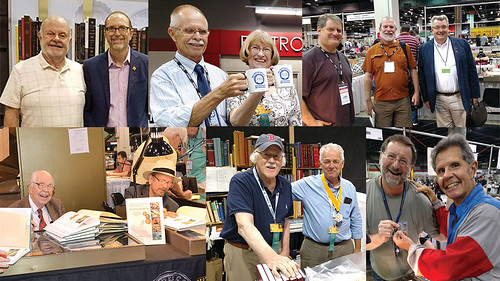

The Numismatic Bibliomania Society will be hosting club table #724 from Tuesday through Friday. We will be displaying some of the highlights from our all important charity auction that will be held during the General Meeting on Friday, and be offering NBS coffee mugs for a $25 donation to the NBS. Please stop by to say "hi" and share your thoughts about the NBS.
Symposium and Meeting
The NBS will be holding our Symposium on Thursday, August 12th at 1:00 PM in room 24. The Symposium will feature a presentation by Rusty Goe who is a recognized authority on the history of the Carson City Mint and its coinage. The title of his presentation is Studying the Carson City Mint and its' Coins.
The Board meeting will be held earlier that day (Thursday the 12th) at 11:30, also in room 7.
The General Meeting will be held on Friday, August 13th at 11:30 AM in room 7. The meeting will include the announcement of the awards for the best articles in our print journal, The Asylum and a presentation by NBS Vice President, Len Augsburger discussing the digitalization of Coin World and Numismatic News.
NBS Benefit Auction
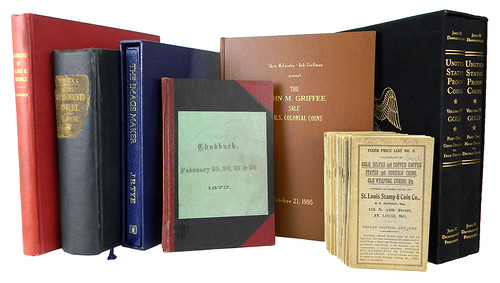
Each year at the ANA World’s Fair of Money, the Numismatic Bibliomania Society conducts a benefit auction to raise funds for the organization. All items sold are donated to the NBS by members and 100% of the proceeds go to the NBS treasury.
This year, we are trying to increase participation in the auction by distributing a catalogue of the sale to all NBS members so that members unable to attend in person can participate. You can download a PDF of the catalogue here.
Absentee bids should be sent to David Fanning at df@numislit.com by the end of Thursday, August 12. The sale will take place on Friday, August 13 as part of the NBS General Meeting, to be held in Room 7 from 11:30 a.m. to 1:30 p.m. Please read the terms of sale before bidding.
There are some great items in this year's sale - please do review the catalog and enter bids if you'll be unable to attend the live sale.
Also, be sure to visit the tables of numismatic literature dealers Charlie Davis and Kolbe & Fanning. Charlie's ad elsewhere in this issue describes what he'll have at tables 828-830. Kolbe & Fanning will be located next door at booth 832, and the next article describes some of what they'll have on hand. -Editor
KOLBE & FANNING AT 2021 ANA
Here's an announcement from Kolbe & Fanning about their table at the ANA. -Editor

Visit us at the ANA World's Fair of Money in Rosemont
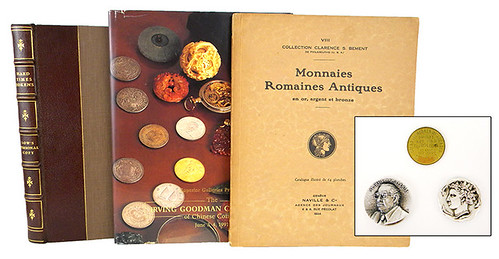
Drop by Booth 832 to browse numismatic titles and visit with us at the American Numismatic Association's World's Fair of Money from August 10–14 at the Donald E. Stephens Convention Center in Rosemont, Illinois.
We will have with us selections from stock, including a number of items that have not yet been listed on our website, as well as material from American and European consignors. A small but interesting group of numismatist tokens, medals and convention badges will also be available for sale.
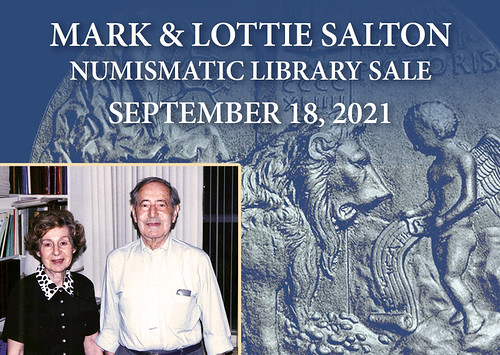
For more information, see:
https://www.numislit.com/
NBS EVENTS AT 2021 ANA TO BE LIVESTREAMED
REMINDER: For those unable to attend this month's American Numismatic Association World's Fair of Money in Rosemont, Lianna Spurrier will be livestreaming some show events, including the NBS General Meeting and Symposium. This is a new development for coin shows - watch ANA history being made! -Editor


 NBS General Meeting
NBS General Meeting
https://vimeo.com/event/1171358
Numismatic Bibliomania Symposium
https://vimeo.com/event/1171349
Liberty Seated Collectors Club
https://vimeo.com/event/1171342
Medal Collectors of America General Meeting
(If previous meeting ends in time)
https://vimeo.com/event/1171352
The ANA itself will be livestreaming some show events. -Editor

The ANA will livestream select activities and events at this year's World's Fair of Money to the ANA Facebook page. Join us at facebook.com/numismatics at the scheduled dates and times to join the fun! The tentative schedule is as follows:
Monday, August 9
1:00 PM CT: Tour of The Tyrant Collection display
Tuesday, August 10
8:30 AM CT: Ringing of the bell from the SS Central America (aka, the "Ship of Gold") with Robert Evans
12:30 PM CT: Opening Ceremony
Thursday, August 12
3:00 PM CT: Highlights from the ANA's Member & Awards Celebration
Friday, August 13
10:00 AM CT: Meet and greet with Benjamin Franklin and Abraham Lincoln impersonators
7:00 PM CT: Highlights from the ANA's 130th Anniversary Awards Banquet
For more information, see:
World's Fair of Money® Livestream Events Schedule
(https://www.money.org/wfm/livestream)
THE BOOK BAZARRE
NEW BOOK: MEXICO'S NUMISMATIC SOCIETY MEDALS
Adrián González-Salinas submitted this information about a new book on Mexico's Numismatic Society Medals. Thank you! -Editor


Catalogue of the Mexico's Numismatic Society Medals 1952-2020 (2nd Edition)
Author: Dr. Luis M. Gómez Wulschner
Width (154 mm) x Length (220 mm) x Thickness (13 mm)
Printing: 500
Pages: 215,(1)
Full Color
Index
- Presentación por Pablo A. Casas-Rábago
- Prólogo by Juan José Risoul-Rosán
- Introducción
- Presentation by Pablo A. Casas-Rábago (english)
- Foreword by Juan José Risoul-Rosán (english)
- Introduction (english)
- Medallas de Aniversario (Anniversary Medals)
- Medallas de Convenciones (Numismatic Conventions Medals)
- Medallas de la 1a. Serie Conmemorativa de la Moneda Mexicana (1st Serie about Commemoratives of Mexican Coinage)
- Medallas de la 2a. Serie Conmemorativa de la Moneda Mexicana (2nd Serie about Commemoratives of Mexican Coinage
- Otras Medallas Conmemorativas (Additional Medals)
- Estampillas Postales de la SoNuMex (Postal stamps related to SoNuMex)
- Tarjetas Telefónicas de la SONuMex (Phone cards related to SoNuMex)
Note: SoNuMex means Sociedad Numismática de México
Mexico's Numismatic Society was founded 11 September 1952. Since 1952, Mexico's Numismatic Society has managed to strike 74 different medals in 8 mexican mints.
The first edition of this catalogue was published in 1996. Every medal has been assigned a catalogue's number including the description of obverse and reverse, the year, mint mark, diameter, the quantity of medals struck in gold, silver, bronze, copper, etc., their availability and some comments to each one. Definitely, it is the best catalogue to know about Mexico's Numismatic Society (SoNuMex) issues (medals, stamps and phone cards), so it's highly recommended to the collector.

For more information, or to order, see:
Catalogo De Medallas 1952 2020 Sociedad Numismatica Mexico
(https://articulo.mercadolibre.com.mx/MLM-847884275-catalogo-de-medallas-1952-2020-sociedad-numismatica-mexico-_JM)

PERIODICAL: C4 NEWSLETTER SUMMER 2021
The Colonial Coin Collectors Club (C4) publishes the C4 Newsletter. At my request, Editor Will Nipper sent me text and images for this article about the issue. Thanks. First, the table of contents. -Editor
- President’s Corner (C. McDonald) and Editor’s Notes
- Statement from the C4 Board
- Lifetime Award for Phil Mossman (C. McDonald)
- 30th Anniversary NJ Copper Symposium (R. Williams)
- Lion Daalders of Zutphen (J. Lipsky)
- Counterfeit Halfpenny Vlack 24-72C (G. Trudgen)
- B. Franklin filling Rev. Whitfield’s Coffers (P. McBride)
- Dr. Thomas Hall’s Connecticut Copper Ephemera (R. Clark)
- Cannon to Coin: Pre-Federal Coin Production (J. Rosen)
- Interview with Anne Bentley, Curator, Mass. Historical Society (J. Burke)
- Survey and Evaluation of 1787 Connecticut Copper Weights (K. Patton)
- Announcements and Errata
- Classified Ads
- Sponsor Ads
- Reciprocal Club Ads
As an example of one of the great articles within, here's an excerpt from an interview with Anne Bentley of the Massachusetts Historical Society. -Editor
 Q: What can you tell us about the Comitia Americana set of silver medals and the unique gold Manly medal in the collection?
Q: What can you tell us about the Comitia Americana set of silver medals and the unique gold Manly medal in the collection?
A: The Washington-Webster set very nearly didn’t survive to be delivered to Washington. When Jefferson brought this case of 11 medals to the U.S. in 1789, Jefferson disembarked, leaving his crates for unlading. The ship caught fire and burned to the water-line but the thick wooden crates and dense packing helped the medals survive. After Washington’s death, a family member bought them and pawned them after the Civil War. Daniel Webster bought them, and left them to his grandson, who later pawned them to W. Elliot Woodward, who stored them in Boston’s Boylston National Bank. Master thief Adam Worth cleared out the vault on November 21, 1869, and escaped to Europe. Fortunately a bank employee had moved the set to an inner vault, untouched by Worth. Webster’s friend, Peter Harvey, bought the set from Woodward and donated them to the Massachusetts Historical Society in 1874.
 The gold Manly medal came to the MHS in William Sumner Appleton, Sr.’s magnificent collection of Washingtoniana and other medals in 1905. He had possibly just acquired it when he displayed it here in 1875, according to the Boston Daily Globe of May 15:
The gold Manly medal came to the MHS in William Sumner Appleton, Sr.’s magnificent collection of Washingtoniana and other medals in 1905. He had possibly just acquired it when he displayed it here in 1875, according to the Boston Daily Globe of May 15:
City and Suburban. The City. Notes of the Day About Town…--The only gold medal of President George Washington of 1790 known to be in this country was exhibited at the monthly meeting of the Massachusetts Historical Society.
It is still considered unique in gold and is handsome indeed.
For more information on the Colonial Coin Collectors Club, see:
https://colonialcoins.org/

PERIODICAL: TAMS JOURNAL JULY-AUGUST 2021
The Token and Medal Society (TAMS) recently published the July-August 2021 issue of The TAMS Journal. At my request, Editor Greg Burns sent me text and images for this article about the issue. Thanks. First, the table of contents. There are always interesting articles found here. -Editor
- C. & P. Mellus Counterstamped Large Cent Ernie Nagy
- It’s Time to Get it Right Larry Baber
- Bard Mercantile Company Token, Bard, California John Duff
- Tokens of the Havre, Montana, Co-Operative Association David E. Schenkman
- Lingering Wisps of Blue Smoke: Santa Cruz, California, Cigar Tokens William D. Hyder
- When Do These Evolve From Souvenirs to Collectible Medals? Mark Benvenuto
- 1881 Yorktown, Virginia, Medal David E. Schenkman
Columns
- From the President Jeff Shevlin
- Fingers on the Keyboard Greg Burns
- Sixty Years Ago in TAMS Paul Cunningham
- American Token Manufacturers & Their Agents David E. Schenkman
- Mavericks John D. Mutch
Society News and Reports
- Secretary’s Report
- General News/Pleas
Etceteras
- Advertisers Index
- TAMS Marketplace
- Letters
- Farewells
- TAMS Membership Application
- Writing for The TAMS Journal Info for Advertisers
Here's an interesting excerpt from John Mutch's article on "maverick" tokens - those whose issuer and place of issuance are unknown, at least until some new research is done. As a bonus, Greg sent images of the token itself, which were not printed in this issue, but appeared in 2011 when originally listed/numbered as a maverick. -Editor

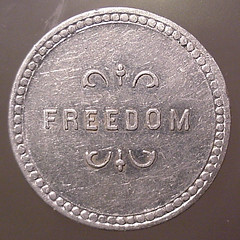
17789: ELI ROSS SOUTER / 401 MASS. AVE. / J. B. S., Buffalo, NY Attributed by: John Mutch, Nick Martin
References: Barnard’s Western NY book, 1908 Buffalo, NY City Directory (John B. Souter - Saloon - 401 Mass av.), 30 Oct 1903 The Buffalo Enquirer, Buffalo, NY (Beer checks used to buy votes)


For more information on the Token and Medal Society, see:
https://www.tokenandmedal.org/

JOEL T. EDLER (1941 - 2021)
Clifford Mishler submitted this remembrance of Krause Publications. George Cuhaj supplied the photo. Thank you! -Editor
 Joel T. Edler, a 22-year member of the Krause Publications numismatic staff, from 1984 to
2006, passed away peacefully on July 27, 2021. Having experienced declining health in recent
years, he and his wife Judy had moved into Iola’s Living Oaks assisted living center earlier this
summer. Born in Freeport, Illinois, on August 19, 1941, Edler was a graduate of Northern Illinois
University in DeKalb. He is survived by his wife, nine children, 17 grandchildren, and three
great-grandchildren.
Joel T. Edler, a 22-year member of the Krause Publications numismatic staff, from 1984 to
2006, passed away peacefully on July 27, 2021. Having experienced declining health in recent
years, he and his wife Judy had moved into Iola’s Living Oaks assisted living center earlier this
summer. Born in Freeport, Illinois, on August 19, 1941, Edler was a graduate of Northern Illinois
University in DeKalb. He is survived by his wife, nine children, 17 grandchildren, and three
great-grandchildren.
Engaged in sales functions throughout his professional career, Edler enjoyed sales stints with the Motorola Corporation and the Fort Howard Paper Company in Green Bay, Wis., prior to becoming engaged with sales pursuits in the numismatic field. His involvement with numismatic sales was inaugurated in 1982 when he joined the Fox Valley Coin & Gun Exchange dealership in Kimberly, Wisconsin.
Edler joined Krause Publications in 1984 as advertising manager of Post Card Collector. When that publication was sold a couple years later, he transferred to the Krause Publication numismatic publications staff, where he served as advertising manager of Numismatic News and other titles for many years. Subsequent to retiring from Krause in 2006, he served as a consultant to Whitman Publishing for a couple years.
Subsequently, he also established Iola’s Country Store, featuring Collectible Antiques, Books &
Magazines,
operating out of a Main Street storefront in downtown Iola. In the early years the
shop, offering a diverse and enticing assortment to vintage collectibles that attracted his
interest, was open on a somewhat erratic schedule. In later years, he famously proclaimed; I’m
open three or four days a year during the annual Iola Old Car Show.
A life-long collector, with a focused interest in numismatics, pressed metal and cast-iron toys, including toys that he had personally preserved from his childhood, and vintage real-photo post cards, Edler attend his first American Numismatic Association in Chicago in 1956 at the age of 15. From 2000 until his retirement, he served Krause as its U.S. coin and paper money pricing supervisor. During that time, he also served as co-author of the U.S. Coin Digest, and the Standard Catalog of United States Paper Money.
Edler served as president of the Village of Iola from 2006 to 2021, having been appointed to the office in 2006, and thereafter elected to seven recurring terms, 2007-2012, stepping down from the office this past April. He had first been elected to the board in 1999.
At the time of his passing, Edler was actively serving as a governor of the Numismatists of Wisconsin, having served on the board continuously since first being elected in 2008. He served as co-host and bourse chairman of four NOW shows hosted in Iola, from the 45 th anniversary event hosted in 2005 to the 55 th in 2015, and was a long-time member of the Nicolet Coin Club in Green Bay.
An active member of the Iola Historical Society, Edler served as the originator and annual organizer of an antique Appraisal Fair, 2008-2019, event conducted in conjunction with the organization’s annual Iola Strawberry Fest, which has been ongoing since 1985. A member of the Iola Lions Club, he was an Iola Old Car Show host committee volunteer.
An avid sports fan, in his earlier years Edler officiated basketball and football at the high school level, after having played center for the Northern Illinois’ Huskies in college. While his lifelong avid football allegiance was to the Chicago Bears, he was also a Green Bay Packers season ticket holder.
I really enjoyed sharing 30 years of travels attending coin and token shows throughout the
Midwest with Joel, a collector par excellence, professionally and in retirement,
Clifford Mishler
observed in reflection. We often paused along the way to take in an antique shop or mall
seeking something irresistible. He was both a most pleasurable companion on these drives, and
a knowledgeable associate for assessing the merits of potential acquisitions.
On those occasions when our drives carried us across the Mississippi River, going or coming,
Mishler continued, he would without fail begin singing his impromptu strains of Hammerstein
and Kern’s Ol’ Man River.
An accomplished singer, he was called upon to provide the vocals
for countless weddings, funerals, and church Christmas programs for area venues.
To read Edler's online obituary, see:
Joel Edler of Iola, Wisconsin | 2021 | Obituary
(https://www.voiefuneralhome.com/obituary/joel-edler)

COIN WORLD TRENDS EDITOR KEITH ZANER
Also passing recently was Coin World Trends editor Keith Zaner. Managing Editor Bill Gibbs provided this story for our readers. Follow the link below for the Coin World piece. Thanks! -Editor
 Anyone who ever worked with Keith Zaner probably has a funny story or two to share about him. One I remember happened on our way back to Sidney from the 1984 ANA Convention in Detroit. Keith and I stopped off at the Henry Ford Museum and Greenfield Village for a few hours to see their magnificent collections. Keith had a lot of fun taking photographs and was excited about all of things he had captured on film; it was not until we returned to the Coin World offices that he found that he had never loaded film into the camera. The office had a good laugh about that.
Anyone who ever worked with Keith Zaner probably has a funny story or two to share about him. One I remember happened on our way back to Sidney from the 1984 ANA Convention in Detroit. Keith and I stopped off at the Henry Ford Museum and Greenfield Village for a few hours to see their magnificent collections. Keith had a lot of fun taking photographs and was excited about all of things he had captured on film; it was not until we returned to the Coin World offices that he found that he had never loaded film into the camera. The office had a good laugh about that.
One of my favorites occurred when the two of us drove from Sidney to a farm estate sale in Indiana that offered some coins. Keith hoped that we might be able to find some gems in the auction. This was Keith’s first such sale, but for those of you familiar with farm estate sales, this was typical; it offered farm equipment, furniture, household items, tools, vehicles, and a lot more. While we were waiting for the coins to be offered, Keith and I were standing outside close to a piece of farm equipment. Having grown up in a rural area of northwest Ohio, I recognized what the equipment was used for. Keith did not and asked what it was. It’s a manure spreader,
I told him. I could tell that he was unsure whether I was telling him the truth or pulling a prank on him. A woman standing nearby laughed and confirmed that I was telling Keith the truth. It was not very clean, and the smell was what you would expect. I explained how and why it was used. We did sit in on the coin portion of the sale, and the coins proved disappointing – the typical holdings of someone who was probably not a serious collector. As I recall, we bought nothing since the winning bids were well above market value.
Keith’s former co-workers and friends will miss him. He was a good guy.
To read the complete article, see:
Former Trends editor Keith Zaner, 69, dies
(https://www.coinworld.com/news/us-coins/former-trends-editor-keith-zaner-69-dies)

MEDAL OF HONOR RECIPIENT WRITES THE MINT
Newman Numismatic Portal intern Garrett Ziss provided the following article based on recently added digital content. Thanks! -Editor
 Symbolism abounds in numismatics, and according to
correspondence from the National Archives, it compelled
Orson W. Bennett to write to the United States Mint in
early 1888. He requested information on the symbolism
behind the Congressional Medal of Honor recently
bestowed upon him for his bravery during the Civil War.
He wished to document this information for his children
who would cherish the medal after he had
Symbolism abounds in numismatics, and according to
correspondence from the National Archives, it compelled
Orson W. Bennett to write to the United States Mint in
early 1888. He requested information on the symbolism
behind the Congressional Medal of Honor recently
bestowed upon him for his bravery during the Civil War.
He wished to document this information for his children
who would cherish the medal after he had mustered out
of life
. Bennett described the medal in his letter but was
hesitant to send it to the Mint for inspection because of
its great sentimental value.
He first enlisted in the Union Army on April 23, 1861, as a private with the 1st Iowa Volunteer Infantry, and subsequently fought in the Battle of Vicksburg during his two years of service with the 12th Wisconsin Volunteer Infantry. Bennett was then promoted to First Lieutenant of Company A of the 102nd United States Colored Infantry, under the command of his older brother, Lieutenant Colonel William True Bennett. At the Battle of Honey Hill, South Carolina on November 30, 1864, Orson W. Bennett completed the mission for which he earned his Medal of Honor. He was ordered by his brother to retrieve three pieces of Confederate artillery located behind enemy lines. Lieutenant Bennett recruited thirty men and carried out his directive with only one soldier wounded.
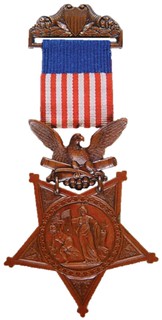 Bennett was awarded the Medal of Honor on March 9, 1887
(the medal shown is not Bennett’s) and as he suspected, the
medal incorporates many symbols. The three most prominent
symbols are the eagle, which represents the United States and
sits atop two cannons with a sword in its claw; the image of
Bennett was awarded the Medal of Honor on March 9, 1887
(the medal shown is not Bennett’s) and as he suspected, the
medal incorporates many symbols. The three most prominent
symbols are the eagle, which represents the United States and
sits atop two cannons with a sword in its claw; the image of
Minerva Repulsing Discord
in the center of the star, which
reflects the discord of the Civil War; and the circle of 34 stars,
which represents each state in the Union (including the
Confederate states) as of 1862 when the medal’s design was adopted. Bennett ultimately
attained the rank of Major and was discharged from the Army on September 30, 1865, in
Charleston, South Carolina.
Image: Orson W. Bennett (Image Courtesy of findagrave.com)
Image: U.S. Army Medal of Honor, Type 1, with the ribbon style used until 1896 (Image Courtesy of militarytrader.com)
Link to letters from Orson W. Bennett to Superintendent of the Mint Daniel M. Fox:
https://archive.org/search.php?query=creator%3A%22U.S.%20Mint%22%20Civil%20War%20Medal

VIDEO: RALPH ROSS VISITS 2001 HOUSTON SHOW
These are selections from the David Lisot Video Library that feature news and personalities from the world of coin collecting. David has been attending coin conventions since 1972 and began videotaping in 1985. The Newman Numismatic Portal now lists all David’s videos on their website at:
https://nnp.wustl.edu/library/multimediadetail/522852
Here's one with Dr. Ralph Ross. -Editor
Field Trip to a Coin Show with Ralph Ross, 2001
David Lisot Video Library (2001)
 Ralph Ross, Ph.D. is incoming president of the American Numismatic Association. He is no newcomer to the coin hobby. He has a long path of devotion to education about coins. In this archival video from the David Lisot Video Library posted on the Newman Numismatic Portal Dr. Ross takes you to the Greater Houston Money Show in 2001. Walk around with him as he leads on a journey through all the things you can see at a coin show.
Ralph Ross, Ph.D. is incoming president of the American Numismatic Association. He is no newcomer to the coin hobby. He has a long path of devotion to education about coins. In this archival video from the David Lisot Video Library posted on the Newman Numismatic Portal Dr. Ross takes you to the Greater Houston Money Show in 2001. Walk around with him as he leads on a journey through all the things you can see at a coin show.
Speaker: Ralph Ross.
The video is available for viewing on NNP at:
https://nnp.wustl.edu/library/book/578895
AUDIO: COINWEEK PODCAST: JAMES MCCARTNEY
Check out this CoinWeek podcast with numismatic researcher James McCartney. -Editor
CoinWeek Podcast #162: James McCartney: From Coins to Catalogs
Today we are joined by James McCartney, senior numismatist and consignment director at Stack’s Bowers. In this episode, we talk about a side of the coin collecting market not experienced by most collectors. We talk about cataloging and what goes into that skill set. We talk about great coins that have passed through during his time with the firm. We also talk about what things that collectors can do to cross that gap between collector and professional numismatist. We also talk a little bit about specialization. All this is next on the CoinWeek Podcast.
To listen to the podcast, see:
CoinWeek Podcast #162: James McCartney: From Coins to Catalogs
(https://coinweek.com/coinweek-podcast/coinweek-podcast-162-james-mccartney-from-coins-to-catalogs/)

PROMOTING THE E-SYLUM
Readers and advertisers have been helping to promote our publication. The latest is Dennis Tucker of Whitman Publishing who penned this article on Coin Update. Thank you! -Editor

When I meet people for the first time and they ask what I do, many are intrigued by the idea of book publishing. To some, it seems charmingly old-fashioned, like meeting a chimney sweep or a calligrapher. Makes me feel like I’ve stepped off the pages of a storybook. But I try not to get too deep into the weeds, because that’s when eyes start to glaze over.
Coin books? Whoever thinks about coin books?
Turns out a lot of people do. And there’s a wonderful resource for keeping up with the field: The E-Sylum, a free weekly email newsletter managed by Wayne Homren and published by the Numismatic Bibliomania Society.
It’s for collectors and anyone else interested in the history and artistry of coins, medals, tokens, and paper money—and the books written and published about them.
In just over 20 years, in an Internet environment swarming with noise, clutter, and confusion, The E-Sylum has emerged as a rock-solid haven for numismatic news and authoritative information. It’s entertaining, at times provocative, and always thought-provoking.
If you’re writing a book and want to talk with people who can aid your research, The E-Sylum is it: An invaluable meeting place, remarkably productive for crowdsourcing and dialogue.
And if you just want to keep up-to-date on new books published weekly, around the world, on every possible numismatic subject, The E-Sylum is the place to go.
I liken it to a fin de siècle Viennese café in the atrium of a numismatic research library nestled in the center of a 20-story, 10-block history museum. Yeah, you have to bring your own drink—but you can’t beat free admission to such a resource.
Visit The E-Sylum online. Take a look at a sample issue. Find out where the weird name comes from. And sign up to get the free weekly newsletter in your inbox. The world of hobby publishing awaits!
To read the complete article, see:
Notes Published: What’s new in numismatic publishing? Find out in The E-Sylum!
(https://news.coinupdate.com/notes-published-whats-new-in-numismatic-publishing-find-out-in-the-e-sylum/)
Thanks also to Kenny Sammut, Jacob Lipson and others who have recently promoted The E-Sylum in their blogs and on their websites. It's greatly appreciated. Invite your numismatic friends and acquaintances to check us out at http://e-sylum.org/ . Here's the latest reader endorsement. Thanks, Chriss! -Editor
"Congratulations on a job that is done not only well, but above and beyond what we coin folks think we need! I was so pleased to hear you and The E-Sylum are getting the "gold medal" in best electronic publication 2021 Barbara J. Gregory Outstanding Club Publications competition, you deserve it, you do a fantastic and often thankless job of putting out the best and most interesting weekly newsletter in numismatics - period!"
Chriss Hoffman, ANA LM #3288, EAC #6202, NBS

UNITED STATES SPACE AGE MEDALS
Dave Lange writes:
"Included among the featured items from the upcoming Holabird auction was a pamphlet announcing The World's First United States Space Age Coin, and you expressed wonderment at what that might be. Well, a company called Northwest Historical Medals, Inc. commissioned Whitman to produce a Bookshelf album to hold the nine-medal set produced for Seattle's Century 21 Exposition in 1962. "
Dave passed along these images from his book on Whitman folders and medals. Thanks! -Editor
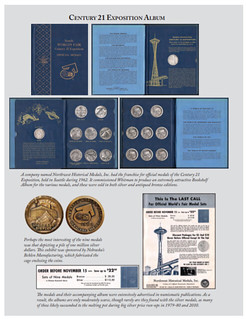


To read the earlier E-Sylum article, see:
SELECTIONS FROM HOLABIRD AUGUST 2021 SALES : Lot 4436: U. S. Medal Group
(https://www.coinbooks.org/v24/esylum_v24n31a24.html)

NOTES FROM E-SYLUM READERS: AUGUST 8, 2021
The Three Thomas'sLast week I asked about the "Three Thomas's" referenced on this 1796 Middlesex Farthing Conder token. -Editor


Dave Schenkman writes:
"More, Paine, and Spence"
Andy Singer writes:
"The Three Thomas’s were Thomas Spence, Sir Thomas More, and Thomas Paine. The Farthing token which was illustrated is Dalton and Hamer 1121. Another Farthing struck a year earlier (1795) lists the three Thomas’s in the center in four lines, surrounded by ADVOCATES OF THE RIGHTS OF MAN (D&H #s 1112-1119). These were part of Spence’s Political and Social Series
of tokens."
Michael Wehner writes:
"The three Thomas's are named on some of the Thomas Spence tokens.
Thomas Spence
Sir Thomas More
Thomas Paine
All three had objections to the British monarchy. Two were contemporaries. Spence issued protest tokens and authored a pamphlet series call "Pig's Meat or Lessons for the Swinish Multitudes". Here is one with the Royal symbols being trampled by the pig. Paine wrote "Common Sense", a factor in the American Revolution. Sir Thomas More was executed much earlier for his opposition to Henry VIII's establishment of the Church of England."

Thanks, everyone! -Editor
To read the earlier E-Sylum article, see:
NUMISMATIC NUGGETS: AUGUST 1, 2021 : 1796 Middlesex Farthing Conder Token
(https://www.coinbooks.org/v24/esylum_v24n31a27.html)
Peter Jones writes:
"Funny — when I looked at the description of When Money Talks, I thought, "I've got that already!" Sure enough I have Money a History, published by the British Museum Press in 1997. The front cover is identical — The Money-lender and his Wife, by Quentin Matsys c. 1514! Just thought I'd mention it as I am sure others will will have the same deja vu!"


It's certainly a familiar image. Nice catch. -Editor
To read the earlier E-Sylum article, see:
NEW BOOK: WHEN MONEY TALKS
(https://www.coinbooks.org/v24/esylum_v24n31a05.html)
Pete Smith writes:
"The four words are CYCLE, VALET, VANITY, FLORAL.
The Solution is COLLECTIVELY.
Does this qualify me for an E-Sylum Smarty Pants Award?"
Sure, why not? We have two winners for this one, but what the heck, I'll give out two Golds. -Editor
Ron Haller-Williams writes:
"I tried it, and got CYCLE, VALET, VANITY, FLORAL to produce CCEVLEITYLOL = COLLECTIVELY. If you prefer it in a picture, here goes:"

To read the earlier E-Sylum article, see:
NOTES FROM E-SYLUM READERS: AUGUST 1, 2021 : Coins in the Comics
(https://www.coinbooks.org/v24/esylum_v24n31a16.html)
Carol Bastable writes:
"I found this interesting and thought I would share it. This is an eBay listing for a government issue postal card. It is a little different than the picture postcards that many like to collect. This was mailed in 1897 by the Chief of Police. It is a notification about a robbery on New Year's Day 1897. Included in the stolen items were two five dollar gold coins and a child's bank with 35 copper pennies. Yes, they were referenced as pennies and not cents. I think the word penny has been engrained in people's minds for a very long time now. I suppose robberies were less common then and police were diligent about finding these types of criminals. "

I have seen early broadsides about stolen coins, but I think this is the first I've seen such a thing from the postcard era. -Editor
To read the earlier E-Sylum article, see:
US -STOLEN! GOLD-watches,rings,coin,jewelry PRIVATE PRINTED POSTAL CARD
(https://www.ebay.com/itm/US-STOLEN-GOLD-watches-rings-coin-jewelry-PRIVATE-PRINTED-POSTAL-CARD-/371877318495)
Allan Julius Behul of Mexico City writes:
 "Had a great radio interview last week about numismatics, which was an hour long. General public, easy chat, tips about collecting, etc. etc.
"Had a great radio interview last week about numismatics, which was an hour long. General public, easy chat, tips about collecting, etc. etc.
"Have also quite recently published a short series of numismatic videos in Spanish on YouTube. The title of the series is in English: N.S.I. - Numismatic Scene Investigation... Even though they are in Spanish, it's quite understandable for non-speakers...have a look if you can.
"Am currently working on a number of numismatic articles, investigations etc....progressing nicely..."
There are several videos available. Have a look! -Editor
To watch the videos, see:
Numismatic Scene Investigation
(https://www.youtube.com/results?search_query=nsi+ajbehul)

ON OLD NUMISMATIC PHOTOGRAPHS
Dave Lange submitted these thoughts on some old numismatic photographs. Thanks! -Editor
 It's interesting how investigating one item often leads to a string of discoveries. Occasionally I buy old photographs that include numismatic content, many of these coming from dispersed newspaper archives as print media dwindles. One such photo is attached and shows a view of Riverside Coin Co., its window declaring that it's also The Wooden Nickel Co. I thought this was just too interesting to pass up, and when the photo arrived I did a search on both names. I actually found several wooden nickels for sale on eBay that were issued by Riverside Coin Company in San Antonio. The seller's photo of one entry is attached.
It's interesting how investigating one item often leads to a string of discoveries. Occasionally I buy old photographs that include numismatic content, many of these coming from dispersed newspaper archives as print media dwindles. One such photo is attached and shows a view of Riverside Coin Co., its window declaring that it's also The Wooden Nickel Co. I thought this was just too interesting to pass up, and when the photo arrived I did a search on both names. I actually found several wooden nickels for sale on eBay that were issued by Riverside Coin Company in San Antonio. The seller's photo of one entry is attached.
Reflected in the store's window is the rear end of an early 1960s automobile, so that probably gives us a good idea of when the photo was taken. I'm tempted to conclude that it's a Ford Falcon, my first set of wheels, but others may disagree. I was curious whether this coin store is still in operation, so I googled "coin stores in San Antonio." Sure enough the store is still there at the same address, 431 E. Commerce Street, but now its name is Royalty Coins. I immediately recognized that as a company from which I'd bought coins myself some years ago at a show.

 In the same day's mail as the photograph was a brochure for The ELBE Line of stamp albums and stock books. It's quite small when folded, as in the photo, but it opens up to a rather grand expanse. Why would I want a stamp collecting catalog? Well, a few years after this 1952-dated flyer was issued ELBE began making ring binders to hold Raymond National and Meghrig American coin album pages. These binders are included in my book on those two album lines, and a couple photos of the ELBE binder are attached.
In the same day's mail as the photograph was a brochure for The ELBE Line of stamp albums and stock books. It's quite small when folded, as in the photo, but it opens up to a rather grand expanse. Why would I want a stamp collecting catalog? Well, a few years after this 1952-dated flyer was issued ELBE began making ring binders to hold Raymond National and Meghrig American coin album pages. These binders are included in my book on those two album lines, and a couple photos of the ELBE binder are attached.
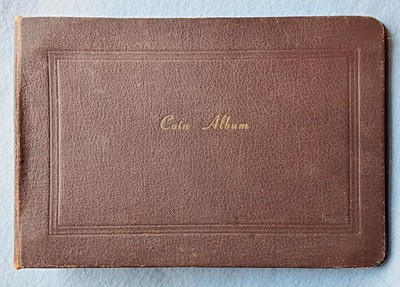

Finally, I have one more photo from 1967 that shows two New Orleans boys, Bryce J. Le Blanc, age 12 and his brother Gregory, 10, examining an old coin. I think it's fairly easy to determine the nature of the coin shown, though not its date. Readers may want to offer their own attributions, so I'm including a high resolution close up of it.

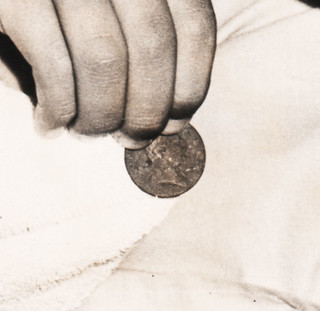
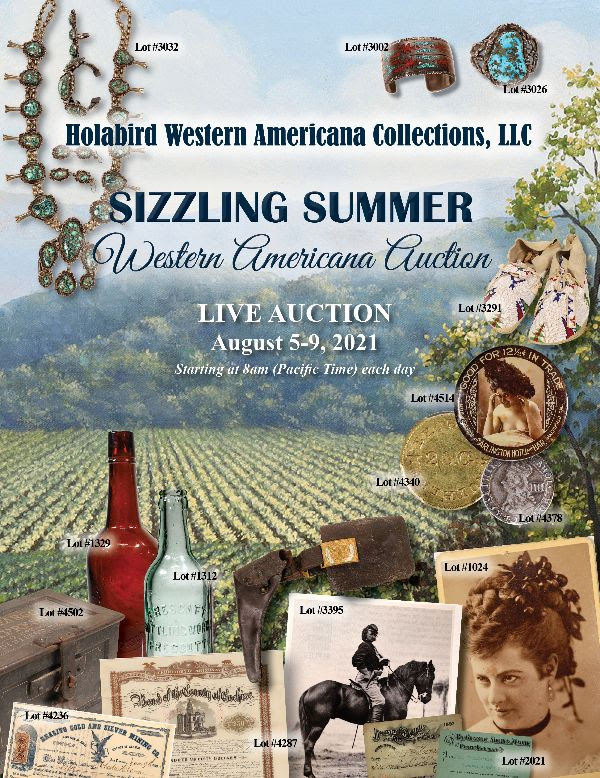
AUTHORS BRESSETT AND GARRETT AT THE ANA
Whitman authors Ken Bressett and Jeff Garrett will autograph books at this week's ANA. Don't miss the opportunity! Here's the press release. -Editor
Will Autograph Books at the American Numismatic Association World’s Fair of Money


Bressett and Garrett at earlier shows
Coin collectors have a chance to meet two hobby legends at the American Numismatic Association World’s Fair of Money, held August 10–14, 2021. Whitman Publishing authors Kenneth Bressett and Jeff Garrett will visit with collectors and sign copies of the hobby’s most famous books at the Whitman booth at the Donald E. Stephens Convention Center in Chicago (Rosemont), Illinois.
Ken Bressett is editor emeritus of the Guide Book of United States Coins (popularly known as the Red Book
), which celebrates its 75th edition this year, and of the Handbook of United States Coins (the wholesale-pricing Blue Book) and Mega Red (the 1,504-page expanded version of the Red Book).
His newest title is A Penny Saved: R.S. Yeoman and His Remarkable Red Book, which makes its public debut at the ANA show. This richly illustrated volume tells the history of Whitman Publishing and the Red Book, along with a biography of its original author, R.S. Yeoman, and an autobiography of Bressett himself.
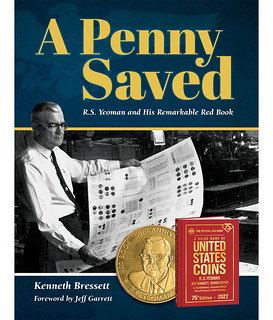

Jeff Garrett, a professional numismatist and former president of the ANA, took over from Bressett as senior editor of the Red Book and the Blue Book in 2018. He also serves as valuations editor of Mega Red, which is edited by another hobby legend, Q. David Bowers.
The collectible hardcover 75th-edition Red Book features a special silver-foil cover to mark its milestone anniversary. More than 25 million copies of the book have been sold since it debuted in 1946. Many hobbyists collect the Red Book itself, including varieties and special editions.
Whitman book-signing sessions give collectors a rare chance to meet some of our favorite hobby authors in person,
said Whitman publisher Dennis Tucker. Bring your camera and take a selfie with Ken Bressett and Jeff Garrett. You’ll always take home amazing memories from the ANA World’s Fair of Money.

Whitman Publishing is located at booth #429, at the end of the Ultra-Premium section, near the display of the Tyrant Collection of rare coins. Bressett and Garrett are scheduled to autograph books at 11:30 a.m. and 2:30 p.m. Thursday, August 12, and Friday, August 13.
I highly encourage readers who are attending the show to visit the Whitman booth and meet the authors. Besides Dave Bowers, I can barely think of another living numismatist besides Ken Bressett with such a span of numismatic experience and accomplishment. Young collectors in particular should take the opportunity to meet the man who worked with Redbook founder Richard Yeoman and met early 20th century dealers like B. Max Mehl. I hope to get an autograph myself so maybe I'll see you in line. I have a copy of the new A Penny Saved book that I hope to finish on the airplane. It's a large, well-written and well-illustrated book, and I've already learned a lot from the early chapters. -Editor
To read the earlier E-Sylum articles, see:
NEW BOOK: GUIDE BOOK OF U.S. COINS, 75TH ED.
(https://www.coinbooks.org/v24/esylum_v24n11a02.html)
NEW BOOK: A PENNY SAVED
(https://www.coinbooks.org/v24/esylum_v24n16a02.html)
AN EDITOR'S APPRECIATION FOR A PENNY SAVED
(https://www.coinbooks.org/v24/esylum_v24n20a05.html)

EXHIBIT: FRANKLIN'S LIBERTAS AMERICANA MEDALS
This press release announces a display of two original Libertas Americana medals at the Stack's Bowers table at next week's ANA convention. -Editor
Illustrated by the Cardinal Collection – A Multi-Million Dollar Display
Stack’s Bowers Galleries will be hosting an impressive display at the August 2021 World’s Fair of Money Convention in Chicago, August 9-13, 2021 at their bourse table 201/300. It will showcase the historical importance of the Libertas Americana medal and will feature two original Libertas Americana medals that Benjamin Franklin received on April 4th , 1783, each bearing the earliest die state. Due to their early state, it is certain that Franklin presented them to the highest VIPs of the day. Accompanying the exhibit are astonishing artifacts not seen for more than 200 years.

Following the decisive victories at Saratoga and Yorktown, Benjamin Franklin wrote to United States Secretary of Foreign Affairs Robert Livingston: This puts me in mind of a medal I have had a mind to strike ... representing the United States by the figure of an infant Hercules in his cradle, strangling the two serpents; and France by that of Minerva, sitting by as his nurse, with her spear and helmet, and her robe specked by a few ‘fleurs-de-lis.’
Franklin’s vision of Liberty, in concert with the work of master engraver Augustin Dupre, resulted in the beautiful Libertas Americana Medal produced in 1783. This medal struck a chord with the people and nations of the world, and ultimately became the inspiration for the Flowing Hair Liberty coinage of the first U.S. Mint. Not surprisingly, it has remained the unanimous choice for the Number 1 spot among the 100 Greatest American Medals and Tokens.
To read earlier E-Sylum articles, see:
FRANKLIN’S LIBERTAS AMERICANA MEDAL EXHIBIT
(https://www.coinbooks.org/v22/esylum_v22n30a22.html)
FRANKLIN'S LIBERTAS AMERICANA MEDAL DISPLAY
(https://www.coinbooks.org/v22/esylum_v22n51a15.html)
THE BOOK BAZARRE
VOCABULARY TERM: FEUCHTWANGER COMPOSITION
Here's another entry from Dick Johnson's Encyclopedia of Coin and Medal Terminology. I added images of Feuchtwanger and one of his tokens. -Editor
 Feuchtwanger Composition.
A three-component alloy employed for several private issue tokens – and proposed for United States coinage by its developer – but never accepted. In 1837 a New York City dentist, Dr Lewis Feuchtwanger, created the composition of 53 copper, 29 zinc and 18 nickel. Its silver gray color resembles copper-nickel. He had several varieties of three-cent tokens in this composition struck by Scovill of Waterbury. His proposal to the U.S. Treasury Department was wisely rejected for striking minor coins however. (At the time it would have been a nightmare of scrap technology in recovering the medals from worn coins.)
Feuchtwanger Composition.
A three-component alloy employed for several private issue tokens – and proposed for United States coinage by its developer – but never accepted. In 1837 a New York City dentist, Dr Lewis Feuchtwanger, created the composition of 53 copper, 29 zinc and 18 nickel. Its silver gray color resembles copper-nickel. He had several varieties of three-cent tokens in this composition struck by Scovill of Waterbury. His proposal to the U.S. Treasury Department was wisely rejected for striking minor coins however. (At the time it would have been a nightmare of scrap technology in recovering the medals from worn coins.)
Unsuccessful at the U.S. Treasury, he turned to private industry, but his proposed alloy was not immediately put to commercial use. In effect, Feuchtwanger was just slightly ahead of his time. What he proposed was one of many formulations of german-silver, or what we called today nickel-silver. It was a hard wearing formula, ideal for badges and such.
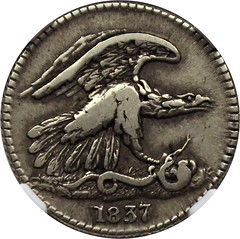

References:
O12 {1988} Breen, p 215; 701 (German-silver entry).
To read the complete entry on the Newman Numismatic Portal, see:
Feuchtwanger Composition
(https://nnp.wustl.edu/library/dictionarydetail/515895)

HOWARD GIBBS AND JOHNNY UNITAS
Last week Pete Smith asked, "Returning to an athletic field for next week’s E-Sylum Smarty-Pants Award, what American numismatist was the step-father of football’s Johnny Unitas?" -Editor
Richard Crosby writes:
"I heard this question a long time ago at a coin club meeting. Guessing it was either Howard Gibbs or Emerson Smith."
Larry Dziubek writes:
"Howard Gibbs of course."
I thought we'd hear from Pittsburgh. Here are a couple photos sent in by Pat McBride followed by Pete's response. The photos were taken at the 1964 Penn-Ohio Convention in Pittsburgh. -Editor


LEFT: Howard D. Gibbs
RIGHT: Howard D. Gibbs with Harry Zeigschmidt, at that time the oldest living collector in Western Pennsylvania
Before we get to the answer, let’s review a little about Johnny Unitas.
John Constantine Unitas (1933-2002) was born in Pittsburgh to Francis J. Unitas and Helen Superfisky. His father died when he was five and he was raised by his mother.
Unitas played professional football with the Baltimore Colts and was voted most valuable player in 1959, 1964 and 1967. He was inducted into the Pro Football Hall of Fame in 1979. Late in life he suffered from injuries incurred while playing football.
The mother of Johnny Unitas, Helen Superfisky, remarried Howard Gibbs. Thus, Howard Gibbs is the answer to the question of the week.
Howard Dunleath Gibbs was born in Pittsburgh on March 11, 1895. He married Louise H. Fellows in 1913 and they had a son and a daughter. At the time of the 1940 Census, he was married to Dorothy Brownhill with two young daughters. Later in life he married Helen Superfisky Unitas.
In 1917 he listed his employment as a stenographer with the Bureau of Mines. In 1930 he was listed as a salesman with a coal company. He rose through the company to regional manager for the Pittsburgh Coal Company and was a director of the Retail Coal Merchants of Western Pennsylvania Association. He was also director of the American Trucking Association.
He joined the ANA as member 1949 in 1917. Gibbs was a serious collector of Odd and Curious
money and assembled a collection estimated at more than 200,000 items. He corresponded with missionaries in Africa and around the world looking for curious money. A major addition to his collection came when he acquired the copper coins collected by Ole Ecklund. Coins from his collection and estate were included in a bakers-dozen sales by Schulman during 1951 to 1972.
Gibbs served as president of the Pittsburgh Coin Club. He was a patron of the American Numismatic Society and a fellow of the Royal Numismatic Societies of England and Belgium.
Among his credits would be the title of Director of the Pittsburgh Numismatic Museum. He used this title to obtain an example of Yap stone money for this museum. However, this institution was a one-person operation located at his residence.
Gibbs died in Pittsburgh on his seventy-fifth birthday, March 11, 1970.
Wayne Homren has scheduled a talk on Gibbs during the 2021 ANA World’s Fair of Money.
If you're at the show this week, stop by the meeting of the International Primitive Money Society Friday, August 13, from 4:00 to 5:00 p.m. in Room 24 to hear my talk with colorful stories (and tall tales) about collecting primitive money and my own Indiana Jones style tale involving Howard Gibbs, Emerson Smith and collecting numismatic archival material American-Ninja style. -Editor
Pete Smith writes:
"This week we offer the E-Sylum Smarty-Pants Award to the first person to correctly answer this question: What person named Eliasberg is in the Hall of Fame in Colorado Springs?"
To read the earlier E-Sylum articles, see:
HOWARD GIBBS, PRINCE OF PRIMITIVE MONEY
(https://www.coinbooks.org/v24/esylum_v24n31a13.html)
EDGAR HOLMES ADAMS
(https://www.coinbooks.org/v24/esylum_v24n31a20.html)
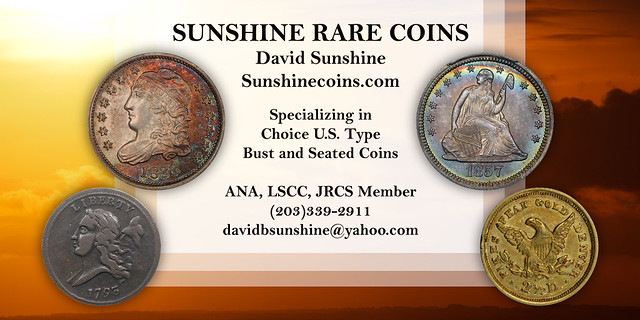
MAKING CENTS AT THE U.S. MINTS
Yesterday I came across this great gallery of old Associated Press photos related to the U.S. cent. Here are a couple - see the complete collection online. -Editor
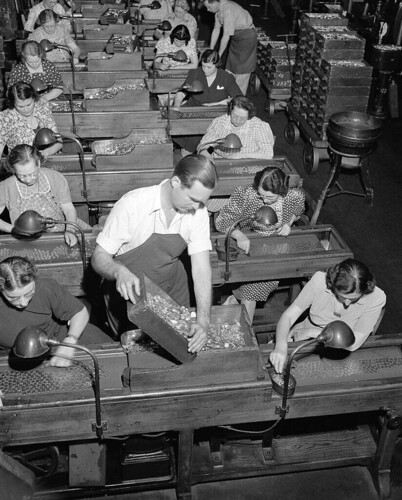
Female employees inspect copper coins for flaws as the pennies go by on belts at the U.S. Mint in Philadelphia, Oct. 29, 1941. The man in foreground is giving them a fresh supply. (AP Photo)

Mrs. Alma Schneider, right, superintendent of the U.S. Mint in Denver, Co., watches as pressman Robert Tebeau scoops blank pennies into a stamping machine, May 29, 1958. Mrs. Schneider, the first woman superintendent of a mint, says the Denver plant is at peak production, turning out 8.5 million coins a day, three fourths of them pennies. (AP Photo)
To read the complete article, see:
Galleries: History of the penny
(https://www.pantagraph.com/galleries-history-of-the-penny/collection_83553ca8-630b-5218-a2e5-6f01c4be4460.html#1)
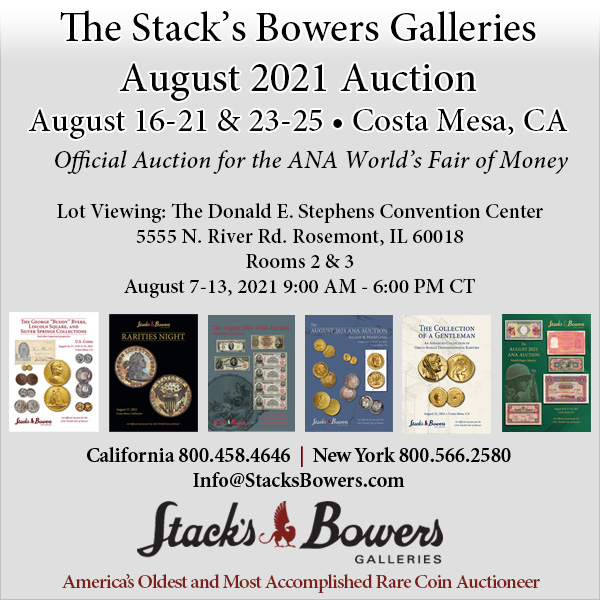
VISITING THE NEW ORLEANS MINT MUSEUM
Over on the PCGS site, Joshua McMorrow-Hernandez published a nice article about a visit to the New Orleans Mint Museum. Here's an excerpt - see the complete article online. And see also the article on 1861-O Half Dollars in the Loose Change section of this issue. -Editor
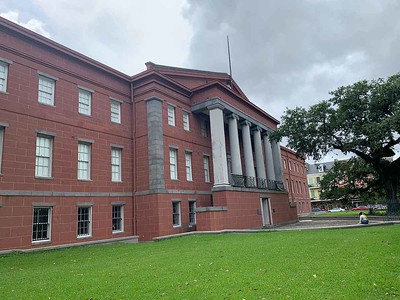
The New Orleans Mint opened in 1838 and was among the first of three branch facilities established by the United States Mint that year. The New Orleans Mint, with its coins bearing an O
mint mark, was by far the longest-lived and most productive of that trio of first branch mints, which also included a facility in Dahlonega, Georgia, and another in Charlotte, North Carolina; those latter two mints, situated near 1820s gold rush territory in the lower Appalachian Mountains, produced solely gold coinage. Meanwhile, the New Orleans Mint struck both gold and silver coins, doing so during a timeframe that spanned some 71 years.
It wasn’t seven straight decades of operation for the New Orleans Mint… In 1861, the United States Civil War saw occupation of the facility by Southern Rebels, who occupied all three mints in the South. The Confederates intended to make the New Orleans Mint a headquarters for coinage production in the Confederate States of America, for which New Orleans would have proven to be a strategically important city both in terms of its large population and major seaport.
However, in 1862 Union forces reclaimed the New Orleans Mint building, which years later saw use as an assay office beginning in 1876 and returned to minting coins in 1879. Some 30 years later, in 1909, the last coins rolled off presses at the New Orleans Mint and the building was formally decommissioned as a mint in 1911. The assay operations shut down there in 1932 and the building served as a Federal prison until 1943, after which it became a storage site for the United States Coast Guard. The state of Louisiana took ownership of the building in 1965, with the building converted into a branch of the Louisiana State Museum in 1981 and serving a role as a museum of both New Orleans minting and coinage as well as jazz music – a cultural touchstone of the city known as The Big Easy.
What’s it Like to Visit the New Orleans Mint Museum?
The New Orleans Mint Museum offers three stories of attractions, including exhibits pertaining to the New Orleans Mint and its coinage on the first floor, several rooms showcasing collections of jazz history mostly confined to the second floor, and a theater for performing arts on the third. This New Orleans landmark is an absolute must-see attraction for any coin collector visiting the city, and not only because it offers a well-rounded body of numismatic material. It is the oldest existing structure to have served as a United States Mint facility.

To read the complete article, see:
Visiting The New Orleans Mint Museum
(https://www.pcgs.com/news/visiting-the-new-orleans-mint-museum)

STACK'S BOWERS AUGUST 2021 AUCTION SELECTIONS
Here are several lots that caught my eye in the upcoming Stack's Bowers ANA World's Fair of Money sales. -Editor

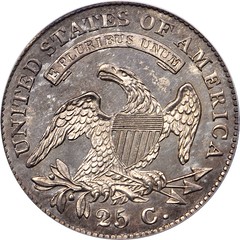
The Mickley-Norweb Specimen of the Original 1827/3/2 Quarter
This is perhaps the most famous Original 1827 quarter, no doubt due to the aforementioned story about Joseph J. Mickley acquiring four Proof 1827 quarters directly from the Philadelphia Mint in late 1827 in change for a dollar. Inasmuch as this is the specimen included in W.E. Woodward's October 1867 sale of the Mickley Collection, this coin has long been described as "J.J. Mickley's Favorite" 1827 quarter. As previously stated, there is no evidence that Mickley ever owned more than one 1827 quarter, and even less evidence for his having acquired any 1827 quarters from the Mint in 1827. There is, however, likely a nugget of truth to this story. As one of the nine founding members of the Numismatic and Antiquarian Society of Philadelphia (along with other early 1827 quarter owners Arthur G. Coffin and John Bohlen), Mickley almost certainly acquired his specimen directly from the Mint, although most likely during the 1850s, and in trade for items desired for the Mint Cabinet Collection not as change for a dollar.
When offered in the 1867 Mickley Collection sale, this coin was lotted as part of a three-piece Proof "set" with an 1827 dime and half dollar, seemingly a concoction of Woodward's to create excitement among bidders. Selling to Joseph P. Reakirt, the coin appeared at the 1962 ANA Convention, and shortly after found its way into the collection of Ambassador and Mrs. R. Henry Norweb. It remained part of the Norweb holdings until sold in Part II of our (Bowers and Merena's) sale of the Norweb Collection, March 1988. Returning to auction in our (Bowers and Merena's) May 1993 Stetson University Collection sale, the coin then entered the renowned cabinet of Dr. William Morton-Smith, whose family has consigned it to the present auction. This sale of the famous Mickley-Norweb Original 1827/3/2 quarter is not the first time Stack's Bowers Galleries has worked with the family. Previously we were selected to bring to market Bill's 1804 dollar, pedigreed to the Berg and Garrett collections; his 1794 dollar, the Lord St. Oswald/Norweb specimen; and the Eliasberg 1913 Liberty Head nickel.
A classic rarity with a classic pedigree. The the complete lot description online for a survey of the numismatic literature around this issue. -Editor
To read the complete lot description, see:
1827/3/2 Capped Bust Quarter. Original. B-1. Rarity-7. Curl Base 2 in 25 C. Proof-65 Cameo (PCGS). CAC.
(https://auctions.stacksbowers.com/lots/view/3-S47VP/182732-capped-bust-quarter-original-b-1-rarity-7-curl-base-2-in-25-c-proof-65-cameo-pcgs-cac)


1796 Capped Bust Right Quarter Eagle. Stars on Obverse. BD-3. Rarity-5+. MS-62 (PCGS).
This is one of the most significant and exciting offerings in this sale - a fresh Mint State 1796 Stars Obverse quarter eagle that has recently been certified by PCGS for the first time and is making its debut in the modern numismatic market. It is a poster example of a classic early U.S. Mint gold rarity.
The offered example is solidly in the Mint State category and offers both absolute and condition rarity. Even more significant, this coin was last offered for sale in the 1970s and, as such, is making its debut in the modern numismatic market. Its earliest known provenance dates to 1926, when the coin was sold by Elmer Sears. A coin dealer in Fall River, Massachusetts, Elmer Snow Sears conducted auctions from 1904 to 1910. He later joined Wayte Raymond in the U.S. Coin Co. in New York and issued a few undated fixed price lists.

This is the coin we discussed in June when Ron Gillio passed along the lot description. -Editor
To read the complete lot description, see:
1796 Capped Bust Right Quarter Eagle. Stars on Obverse. BD-3. Rarity-5+. MS-62 (PCGS).
(https://auctions.stacksbowers.com/lots/view/3-S48HS/1796-capped-bust-right-quarter-eagle-stars-on-obverse-bd-3-rarity-5-ms-62-pcgs)
To read the earlier E-Sylum article, see:
1796 QUARTER EAGLE EX-ELMER SEARS
(https://www.coinbooks.org/v24/esylum_v24n25a13.html)

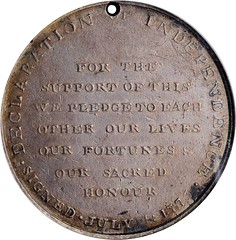
1826 U.S. Semicentennial, The National Medal. HK-2. Rarity-9. Silver. AU-55 (NGC).
40 mm. Pierced for suspension, as always. Exceptional quality for this important rarity in the HK series. Handsome pearl-gray surfaces with steely-olive peripheral toning on the obverse, the obverse border with a few glints of russet associated with light surface scale. Appealing satin to matte-like texture throughout, with all design elements boldly to sharply rendered. Although the origin of this type is unknown, its issuance to commemorate the 50th anniversary of the Declaration of Independence confirms its historical significance and desirability. Silver impressions such as this are the most desirable, although they are formidable rarities with only a handful known. Incredibly, our (Stack's) May 2005 Ford IX Sale included three (!) silver impressions, along with two in white metal (HK-4) and an obverse brockage in brass - an unprecedented offering likely never to be repeated. The offered medal is distinct from the Ford specimens and represents a rare bidding opportunity for specialists.
Unusual item, and interesting. I don't believe I've seen one of these before. -Editor
To read the complete lot description, see:
1826 U.S. Semicentennial, The National Medal. HK-2. Rarity-9. Silver. AU-55 (NGC).
(https://auctions.stacksbowers.com/lots/view/3-S6GK8/1826-us-semicentennial-the-national-medal-hk-2-rarity-9-silver-au-55-ngc)


1862 Sands' Ale. Five Cents. HB-207, EP-90, S-151, Reed-SA05. Rarity-8. Extremely Fine, Environmental Damage.
No more than four denominations of Sands' Ale encasements are believed to exist and, although it is the most readily obtainable, the five cents is still a major rarity with Fred L. Reed assigning it a Rarity-8 rating in his 1995 book Civil War Encased Stamps: Their Issuers and Their Times. The ten cents is Rarity-9 with only two or three specimens known, the thirty cents is believed unique, and Reed notes only a "?" alongside his listing for the twelve cents. The twenty-four cents does not exist for this issuer. The present five cents is the plate piece in the popular 1989 reference The Standard Catalogue of Encased Postage Stamps by Michael J. Hodder and Q. David Bowers, and it is one of the most significant encasements from any issuer that we have offered in recent years. A fleeting bidding opportunity for the specialist that is worthy of serious consideration.
Provenance: From the Q. David Bowers Collection. Earlier ex our (American Numismatic Rarities') sale of the Wayne Homren Collection, June 2006 Lake Michigan & Springdale Collections sale, lot 840, where it realized $18,400; Q. David Bowers. The plate piece in the Hodder-Bowers reference on encased postage stamps.
An old friend. I miss my encased postage collection. This one found a good home with Dave Bowers, and is ready for the next curator to come along. I purchased it from Dr. Wally Lee, making a downpayment and paying in installments over several months. -Editor
To read the complete lot description, see:
1862 Sands' Ale. Five Cents. HB-207, EP-90, S-151, Reed-SA05. Rarity-8. Extremely Fine, Environmental Damage.
(https://auctions.stacksbowers.com/lots/view/3-S6GZB/1862-sands-ale-five-cents-hb-207-ep-90-s-151-reed-sa05-rarity-8-extremely-fine-environmental-damage)

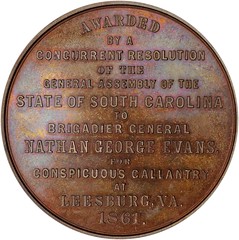
1861 South Carolina Medal to General Nathan George Evans. B861-525c. Bronzed Copper. Prooflike Mint State.
57 mm. Obv: Palmetto tree and Motto ANIMIS OPIBUSQUI PARATI from the South Carolina State Seal. Rev: Fourteen-line inscription AWARDED / BY A / CONCURRENT RESOLUTION / OF THE / GENERAL ASSEMBLY OF THE / STATE OF SOUTH CAROLINA / TO / BRIGADIER GENERAL / NATHAN GEORGE EVANS / FOR / CONSPICUOUS GALLANTRY / AT / LEESBURG, VA. / 1861. Evans was a first lieutenant in the U.S. Army when his home state, South Carolina, became the first state to secede from the Union. He resigned his commission, joined the Confederate Army, was given the rank of colonel, and assigned to a small brigade that prominently participated in the First Battle of Bull Run -- the initial conflict between armies of the U.S.A. and the C.S.A. Three months later at the Battle of Ball's Bluff, Evans' troops successfully routed Union troops that were crossing the Potomac River in an attempt to overrun Evans' camp, but due to errors of strategy on the part of the Union forces, Evans' division forced them back over the bluffs and into the river where most were killed or captured. These early successes earned Colonel Evans promotion to brigadier general.
This rare medal was issued by the Confederate State of South Carolina for actions during the opening months of the war, and one must speculate where the medal was produced. There were no medalists capable of producing a medal of this size and quality in the South, so perhaps it was contracted out to one of the European mints, or conceivably it was produced clandestinely by a medalist in the U.S. It is unsigned, but bears a strong resemblance to the work of Robert Lovett, Jr. of Philadelphia who had the skill and machinery to produce such a medal. His Washington Light Infantry medal of 1860 bears a close stylistic resemblance to this piece. Additionally, Lovett may well have had sympathies for the Confederate cause as he is known to have been illegally contracted to produce the 1861 Confederate cent. Although Lovett typically signed his work prominently, his Confederate cent could not bear an indication of the maker, as is the case with this medal.
A rarely seen medal, with a local connection for me - we live near Leesburg, and the Ball's Bluff battle site is only 10 miles away. -Editor
To read the complete lot description, see:
1861 South Carolina Medal to General Nathan George Evans. B861-525c. Bronzed Copper. Prooflike Mint State.
(https://auctions.stacksbowers.com/lots/view/3-S6GZQ/1861-south-carolina-medal-to-general-nathan-george-evans-b861-525c-bronzed-copper-prooflike-mint-state)


Maryland--Baltimore. HOUCK'S / PANACEA / BALTIMORE in relief within an oblong depression on the obverse of a France undated Paris Mint Force Type 5 francs. Brunk H-779, HT-144. Host coin Very Good.
A rare undertype. -Editor
To read the complete lot description, see:
Maryland--Baltimore. HOUCK'S / PANACEA / BALTIMORE in relief within an oblong depression on the obverse of a France undated Paris Mint F...
(https://auctions.stacksbowers.com/lots/view/3-S6H4S/maryland-baltimore-houcks-panacea-baltimore-in-relief-within-an-oblong-depression-on-the-obverse-of-a-france-undated-paris-mint-f)


Louisiana--New Orleans. PHILLIPS, / CHEAP / STORE. / NAYADES ST. / N. O. on the obverse of a Sardinia 1850 5 lira. Brunk P-449, Rulau-La 104A. Host coin Fine.
Attractively original host coin in silver and olive-gray, the counterstamp firmly impressed. Scarce merchant, in business only from 1849 to 1855, whose counterstamp is particularly elusive on a host of this type. In fact, both the Brunk and Rulau references only report a single Sardinian 5 lira host, an example dated 1844. Rare!
Provenance: From the Q. David Bowers Collection.
While U.S. merchant counterstamps on foreign coins aren't rare, this Italian coin is an undertype I've never seen. Like the Houck's Panacea above, the counterstamp is equally rare evidence of where and when the coin circulated in the U.S. -Editor
To read the complete lot description, see:
Louisiana--New Orleans. PHILLIPS, / CHEAP / STORE. / NAYADES ST. / N. O. on the obverse of a Sardinia 1850 5 lira. Brunk P-449, Rulau-La...
(https://auctions.stacksbowers.com/lots/view/3-S6H56/louisiana-new-orleans-phillips-cheap-store-nayades-st-n-o-on-the-obverse-of-a-sardinia-1850-5-lira-brunk-p-449-rulau-la)


1855 Liberty Head Quarter Eagle--Broadstruck--MS-63 (NGC).
In a word, major Mint errors on classic United States gold coins are rare. Only a handful are known across all series and major Mint error types, and expectantly so since the Mint's quality control procedures were much stricter for gold coins than they were for silver and, especially, minor coins. The 2010 reference 100 Greatest U.S. Error Coins does not feature this specific 1855 quarter eagle, but it does rank a broadstruck 1897 Liberty Head half eagle as #32, the entry for which also pictures a broadstruck 1878-S Liberty Head quarter eagle. Failing to properly seat itself within the collar, the planchet on which this 1855 quarter eagle was struck instead lay atop the collar. The resulting impression from the dies, while imparting full detail to all design elements, caused the planchet to spread out, which is most readily evident as crescents of unstruck planchet along the upper left obverse and lower left reverse.
A super rarity. Mint errors are a window into the manufacturing process, and early gold errors are seldom seen. -Editor
To read the complete lot description, see:
1855 Liberty Head Quarter Eagle--Broadstruck--MS-63 (NGC).
(https://auctions.stacksbowers.com/lots/view/3-S5DGS/1855-liberty-head-quarter-eagle-broadstruck-ms-63-ngc)

FRED WEINBERG RETIRES; HERITAGE TO SELL ERRORS
And speaking of errors, error dealer and longtime E-Sylum supporter Fred Weinberg is retiring. Happy trails! We'll miss you. Heritage submitted this press release on their upcoming sales of highlights from Fred's collection and stock. -Editor
 Longtime collector and error dealer Fred Weinberg has decided to retire after 50 years of being perhaps the most famous face in Mint errors and earning his own pedigree for his Error Coins certified by PCGS.
Longtime collector and error dealer Fred Weinberg has decided to retire after 50 years of being perhaps the most famous face in Mint errors and earning his own pedigree for his Error Coins certified by PCGS.
His retirement means fellow error coin enthusiasts have a chance to acquire many hundreds of coveted error coins during the next year. Special highlights of his rare U.S. coin and currency errors will be on display in Heritage Auctions’ booth during the American Numismatic Association World’s Fair of Money, Aug. 18-22 in Chicago.
I’ve always considered myself incredibly lucky to be able to turn my hobby into a profession,
Weinberg said from his Encino, California, offices. I’ve been a collector since I was eight years old and even dropped out of college to deal in coins.
Throughout his diverse career, Weinberg has taken pride in being one of the original 31 PCGS dealers David Hall appointed to assist PCGS making markets in coins and descriptions in 1986. Being a numismatist has been an incredibly fulfilling job,
he said. There’s never been a moment of boredom. I’ve loved it. I’ve just loved it.
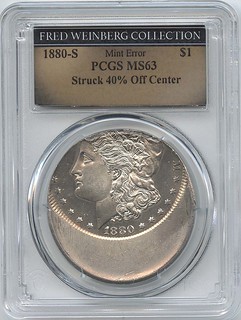

Two special coins from Weinberg’s personal collection which will be on display during ANA are sure to turn people’s heads: one of the finest 1880-S Off Center Morgan dollar and a Sacagawea Quarter/Quarter Mule featuring a coveted state series quarter obverse, one of the roughly 20 known to exist.
Weinberg’s Sacagawea Quarter Mule, graded a stunning MS65+ by PCGS, is the last example from his collection he has. It’s the last new piece to come to market,
he said. Weinberg provides an extensive census and history of the Mule
Sacagawea dollar reverse with a States quarter obverse available on his website.
The 1880-S is the second-finest off-center dollar, with the finest 1884 Carson City dollar not expected to come on the market for possibly 20 to 25 years,
Weinberg said.
The coins are expected to bring in excess of $100,000 each.
We were honored to have been awarded this wonderful consignment by Fred Weinberg, one of the most respected and beloved professional numismatists of our time, said Heritage president, Greg Rohan.
On display will also be a rare Reverse Transitional
error coin – a 1964 Lincoln Cent, struck on a CLAD (instead of silver) Dime Planchet, PCGS MS-65 in a larger size PCGS holder, valued at $10,000 or more.

1974 $20 / $10 Double Denomination Error
Following the display at ANA, the coins will head to Heritage’s Florida United Numismatic auctions next year while hundreds of additional coins from his collection are set for auctions throughout 2022. Weinberg’s collection of incomplete punched planchets and elliptical clipped planchets, the largest ever assembled, are expected to come to auction for the first time in years in Heritage’s monthly showcase auctions. The sales will feature approximately 700 to 800 CUD die break errors in 2022.
The coins will mostly be authenticated and graded by PCGS, and feature a pedigree, the label from the Fred Weinberg Collection.
Error coins have a visual aspect that always grabs people,
he said. I’ve always found it fascinating that to the many of the public, an off-center penny is more visually appealing than a nice 1880-S dollar.
In addition to the coins, Weinberg and Heritage will display currency errors at ANA, including A 1977 $5 with an obstructed printing error retaining the obstruction, graded Choice UNC 64 PPQ by PCGS, and a 1974 $20 front, and a $10 reverse, graded PCGS Choice UNC 64 PPQ. Double denomination notes are considered the Rolls Royce
of currency errors.
The U.S. currency errors also feature a pedigree from the Fred Weinberg Collection.
In addition to coins and currency, Weinberg also has decided his important collection of more than 200 psychedelic rock ‘n’ roll concert posters are ready to be auctioned. The posters, including early Bob Dylan & Beatles rarities, will appear in Entertainment & Music Memorabilia auctions in the near future and beyond.
Highlights from the Fred Weinberg collection of U.S. error coins and currency will be on display in Heritage Auctions’ booth during the ANA’s World’s Fair of Money, Aug. 18-22 in Chicago.

JACOB LIPSON CANADIAN SELECTIONS AUGUST 2021
Here's a selection of items I came across in the stock of Canadian dealer Jacob Lipson. In a recent blog post he wrote, "On the NEWPS front, I have purchased a couple of really neat collections since we last spoke. One consisted exclusively of Canadian medals and the other was an incredible accumulation of Canadian military and militia buttons, a few dating to the Revolutionary War and War of 1812. Buttons aren’t something I usually buy, despite being round and struck, but this was too cool to pass up. The Partrick sales have also provided an opportunity to pick up some fantastic Canadian tokens." -Editor


Copper. 28mm x 30mm. 5.90 grams. The obverse shows the portrait of a male figure facing right, described alternately in the literature as George II, an Indian,
or even the Duke of Wellington, his hair tied in a ribbon behind with three forecurls. The reverse depicts Commerce seated on a bale above a diagonally lined base. A scale is outstretched in her right hand and a cornucopia rests in her left. The date 1820 appears in the exergue.
This is one of only two tokens in the Blacksmith series listed by P.N. Breton (1894), who correctly described the variety as rare
but erroneously noted only three or four known. Perhaps he meant known to him. In a 1985 CN Journal article, Warren Baker cited 32 known to him in copper and seven in brass. Baker’s own collection, which was auctioned in 1987, included five examples. One of them was struck over an 1825 farthing, proving that these Blacksmiths were antedated. Another was struck over an example of Wood-6. This piece, which also formed part of the collection, was conservatively described as as Very Fine or better and struck over a counterfeit George II or George III half penny
A classic piece. -Editor
To read the complete item description, see:
1820-Dated Blacksmith Token, Possibly Overstruck, Breton-1008, Wood-19, BL-32A1, XF.
(https://www.jacoblipsonrarecoins.com/inventory/1820-dated-blacksmith-token-possibly-overstruck-breton-1008-wood-19-bl-32a1-xf)


56mm. Leonard Charles Wyon (1826-1891) was a member of the prominent Wyon dynasty of engravers. He is famous in Canada for having cut many of the dies for our own Victorian coinage, including the 1858 Province of Canada issue.
The Royal Society of Arts, Manufactures, and Commerce was established in 1754 by William Shipley. According to the RSA,
Shipley’s belief that the creativity of ideas could enrich social progress was reflected in the diversity of awards offered by the Premium Award Scheme. For the first 100 years the Society encouraged innovation and excellence through this scheme in six areas - Agriculture, Manufacture, Chemistry, Mechanics, Polite Arts, Colonies and Trade.
This bronze medal is engraved on the edge: JETHRO BITHELL. SOCIETY OF ARTS EXAMINATIONS, 1896. SHORTHAND. Bithell was born in Wigan, England and studied German and the University of Manchester, where he graduated in 1900 with first-class honours in Modern Languages. He spent his career teaching German at Birkbeck College, University of London before retiring in 1938. Jethro Bithell died in 1962.
The fields are glossy and unabraded on this well-preserved chocolate-brown representative. Exceptionally struck and attractive. There is a single speck of aqua residue near the rim above RE in PRESIDENT. Housed in its original, blue velvet-lined case of issue.
Nice portrait, great surface. -Editor
To read the complete item description, see:
1863 Prince of Wales, Society of Arts President's Medal in Bronze, Presented in 1896 for Shorthand, Dies by L.C. Wyon, Eimer-1566, BHM-2795, Unc. With Original Box
(https://www.jacoblipsonrarecoins.com/inventory/1863-prince-of-wales-society-of-arts-presidents-medal-in-bronze-presented-in-1896-for-shorthand-dies-by-lc-wyon-eimer-1566-bhm-2795-unc-with-original-box)


White metal. 38 mm. 24.4 grams. The 1886 Grand Bazaar was held to raise money for the continued construction of the Cathedral de Montreal, now the Mary Queen of the Word Cathedral on Réné Lévesque street. Other fundraising events associated with the Grand Bazaar included a concert and a lottery. In all, $27,000 was raised.
Struck by Lymburner, the obverse depicts the cathedral itself with CATHEDRAL DE MONTREAL in the exergue. The reverse inscription reads: SOUVENIR / DU / GRAND BAZAAR / DE LA / CATHEDRAL DE MONTREAL / TENU EN SEPTEMBRE / 1886. This bright example shows as-made planchet cracks on each side, as well as scattered ticks and a few hairlines.
A crude design, but still a nice architectural piece. -Editor
To read the complete item description, see:
1886 Montreal Cathedral Souvenir du Grand Bazaar by Lymburner, Leroux-1175.
(https://www.jacoblipsonrarecoins.com/inventory/1886-montreal-cathedral-souvenir-du-grand-bazaar-by-lymburner-leroux-1175)


Silver. 65 mm. 98.1 grams. Agricultural medals engraved by Rolph, Smith & Co. (Toronto, Ontario) were sponsored by the Canadian Bank of Commerce and issued by various agricultural societies. This particular example was awarded to W.J. Lee & Sons for the best flock of Oxford sheep at the Townsend Agricultural Show in 1904. The surfaces were cleaned about 50 years ago and have since retoned lightly. Minor evidence of residue in the recesses of the design. A scarce medal named in silver.
Great agricultural scene with detail throughout. -Editor
To read the complete item description, see:
1904 Canadian Bank of Commerce Agricultural Medal Named in Silver, Charlton-5045-5.
(https://www.jacoblipsonrarecoins.com/inventory/1904-canadian-bank-of-commerce-agricultural-medal-named-in-silver-charlton-5045-5)
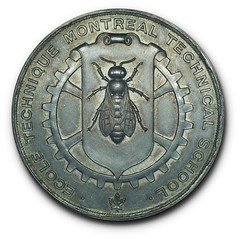

Sterling silver. 54 mm. 73.8 grams. Edge marked C. LAMOND & FILS / STERLING. The obverse features a bee superimposed on a shield over a cog. A maple leaf appears at 6 o’clock and the legend ECOLE TECHNIQUE MONTREAL TECHNICAL SCHOOL rings the border. The reverse shows a laurel wreath tied at the bottom and the recipient’s name engraved in the centre. CARON FRERES MONTREAL is below.
C. Lamond & Fils of Montreal acquired the Caron Frères dies around 1930. Another named silver example dated 1927-28 appeared as part of the Saul Hendler Collection in 1996, where it was described as rare.
This medal is richly toned in gunmetal and golden patina. Completely void of hairlines or other marks. Housed in its original purple velvet box.
Gotta love the bee! -Editor
To read the complete item description, see:
c. 1930 Montreal Technical School Award Medal in Silver. Presented to Joseph Blases. Original Box Included.
(https://www.jacoblipsonrarecoins.com/inventory/c-1930-montreal-technical-school-award-medal-in-silver-presented-to-joseph-blases-original-box-included)

NUMISMAGRAM MEDAL SELECTIONS: AUGUST 2021
Numismagram's Jeremy Bostwick sent along these highlights from his recent addition of new material to his website. In addition to the items listed here, there is a particular focus upon Swedish commemorative medals and WWI-related dog tags/engraved coin art. For all of his new tokens and medals, please visit numismagram.com/inventory. -Editor

101758 | GERMANY. Köln (Cologne). Bronze Medal. Issued 1880. Commemorating the completion of the Kölner Dom (Cologne Cathedral) (51mm, 57.44 g, 12h). By Drentwett. DER DOM ZU KÖLN, façade of the cathedral; banner in exergue reading BEGONNEN 1248 / VOLLENDET 1880 in two lines / "Anbetung der / hl. drei Könige," nativity scene featuring the adoration of the magi; DOMBILD ZU KÖLN in exergue. Edge: Plain. Weiler 155. Gem Mint State. Rich brown surfaces, with tremendous brilliance in the fields and a sparkling iridescence when cradled. $235.
Declared a World Heritage site by UNESCO in 1996, the Cologne Cathedral stands as the tallest twin-spired church in the world at 515 feet high. This medal commemorates the completion of the towers (which would finally occur in 1880), as work had been stalled since the late 15th century.
Nice architectural medal, with a crowded but detailed reverse scene. -Editor
To read the complete item description, see:
101758 | GERMANY. Köln (Cologne). Kölner Dom bronze Medal.
(https://www.numismagram.com/product-page/101758)

101703 | GREAT BRITAIN & UKRAINE Sellafield and Chernobyl cast silver Medal. Issued 1986. Fallout (30mm, 26.20 g, 9h). By M. Appleby. Representations of flora and fauna (tree, fish, and goat) affected by the impact of nuclear fallout and other airborne environmental disasters; all within vertical 'cat eye' border / FALLOUT / 1986 around horizontal 'cat eye' border. Edge: «4 hallmarks». BAMS 37, M10. Gem Mint State. Highly brilliant and mirrored in the fields, with some captivating toning in the recesses. A powerful and rare piece, 1 of just 39 cast by the artist from hand engraved dies. $345.
Produced in the aftermath of the Chernobyl disaster—a nuclear accident in the spring of 1986 near the city of Pripyat in Soviet Ukraine—this moving medal alludes to the impact of the radioactive fallout that touches aspects of life, be it flora or fauna. Due to wind patterns, areas in Northern Europe (like the artist's home country of Scotland) began to see an impact, with particles of caesium-137—a radioactive isotope that is a common product following a fission reaction of the primary "fuel," uranium-235—being scattered across the countryside. Likewise, the much closer Sellafield nuclear power plant, located in northern England near the border with Scotland, has had its own problematic history with contamination. This medal serves as a reminder of the shared experiences of everyone on the planet, and that what can affect one can affect everyone and everything.
Rare and interesting art medal. -Editor
To read the complete item description, see:
101703 | GREAT BRITAIN & UKRAINE. Sellafield and Chernobyl cast silver Medal.
(https://www.numismagram.com/product-page/101703)
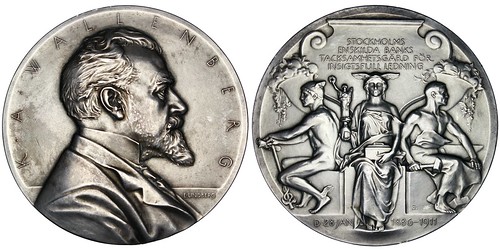
101689 | SWEDEN. Knut Agathon Wallenberg silver Medal. Issued 1911. Commemorating his 25th anniversary as CEO of Stockholms Enskilda Bank (63mm, 127.00 g, 12h). By E. Lindberg. K • A • WALLENBERG, bust right in frock coat / STOCKHOLMS / ENSKILDA BANKS / TACKSAMHETSGÄRD FÖR / INSIGTSFULL LEDNING, female personification of the banking industry seated facing on triple throne, holding victoriola and money chest; to left and right, respectively, seated male personifications of Commerce, holding scroll and caduceus, and Industry, holding hammer; two cornucopias full of fruits behind. Edge: Plain. Ehrensvärd 102. Choice About Uncirculated. Lightly toned on the obverse, with some minor rub and a few scuffs on the reverse. $295.
Part of the extremely wealthy and prominent Wallenburg family, responsible for numerous bankers, industrialists, and diplomats, Knut Agathon succeeded his father, André Oscar, as the head of Stockholms Enskilda Bank in 1886 upon the death of the latter. By the time of the bank's merger in 1972 with Skandinaviska Banken (to become Skandinaviska Enskilda Banken AB), the Wallenberg's family businesses employed some 40% of Sweden's industrial workforce and also represented an astounding 40% of the total worth of the Stockholm stock market.
I'm not sure what to make of the pointy beard, but I really like the reverse. A nice arrangement of three figures is hard to pull off. -Editor
To read the complete item description, see:
101689 | Knut Agathon Wallenberg/Banking silver Medal.
(https://www.numismagram.com/product-page/101689)

101722 | UNITED STATES & ARGENTINA. Thomas A. Edison silvered bronze Medal. Issued 1929. Commemorating the famous inventor and the 50th anniversary of the invention of the incandescent light bulb (71mm, 85.89 g, 12h). By J. C. Oliva Navarro. COMITE DE HOMENAJE / TOMAS ALVA EDISON, bust facing slightly left in frock coat; light bulb and wreath to outer left and right / ASOCIACION–ARGENTINA DE ELECTROTECNICOS / INVENCION DE LA LAMPARA–INCANDESCENTE, nude male advancing right, dropping torch and reaching up toward nude female holding lightbulb; ornately geometric radiant sun pattern in background. Edge: Plain. About Uncirculated. Light gray surfaces, a few minor spots. A fairly rare and very interesting type issued by the Electrical Association of Argentina. $195.
Oft-described as one of America's best and most prolific inventors, Thomas Alva Edison is likely best remembered for his inventing of the light bulb—a feat that seemingly shines the brightest when compared to his many others. This rather interesting medal was issued some 50 years following the release of the light bulb, and done so in South America by the Electrical Association of Argentina. Here, man is seen casting aside the torch in favor of light harnessed through science.
Nice medal with a strong portrait. -Editor
To read the complete item description, see:
101722 | UNITED STATES & ARGENTINA. Thomas A. Edison silvered bronze Medal.
(https://www.numismagram.com/product-page/101722)

'WORLD'S OLDEST' COIN FACTORY FOUND
Ed Hohertz was the first to pass along the story of the early mint discovered in China. Thanks also to Kavan Ratnatunga, Arthur Shippee, and Len Augsburger. -Editor

Archaeologists excavating the remains of Guanzhuang—an ancient city in China’s eastern Henan Province—have discovered what they believe is the oldest-known coin mint, where miniature, shovel-shaped bronze coins were mass produced some 2,600 years ago.
Their research, published today in the journal Antiquity, gives weight to the idea that the first coins were minted not in Turkey or Greece, as long thought, but in China.
The walled and moated city of Guanzhuang was established about 800 B.C., and its foundry— where bronze was cast and beaten into ritual vessels, weapons, and tools—opened in 770 B.C., according to Hao Zhao, an archaeologist at Zhengzhou University and the paper’s lead author. But it wasn’t for another 150 years that workers began minting coins outside the southern gate of the inner city.
Using radiocarbon dating, the team determined the mint began operating sometime between 640 B.C. and no later than 550 B.C. While other research has dated coins from the Lydian Empire in what is now Turkey to as early as 630 B.C., Zhao notes that the earliest mint known to have produced Lydian coins dates to sometime between 575 B.C. and 550 B.C.
The Guanzhuang mint, Zhao says, is currently the world’s oldest-known securely dated minting site.
During their excavation, the researchers found two spade coins—which look like shrunken versions of the gardening tool—and dozens of clay molds used to cast them. One coin was in near-perfect condition: Just shy of 6 inches long and about 2.5 inches wide, the bronze coin weighed about 27 grams, or less than six sheets of standard-size computer paper.
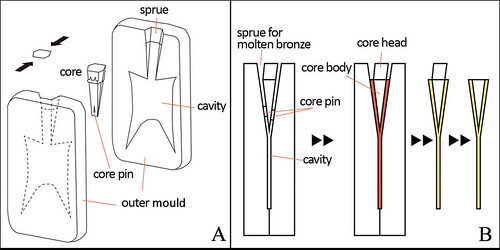
Coins are often found bundled together and completely lacking any of the original context of their production or their use,
says Bill Maurer, a professor of anthropology at the University of California Irvine and director of the Institute for Money, Technology and Financial Inclusion. But in this case, you’ve got the whole mint, and you’ve got the casts that were used.
The completeness of the discovery is what’s remarkable, says Maurer, who was not involved in the research. Finding both coins and their molds is what allowed the researchers to radiocarbon date the mint, lending weight to their assertion that it’s the oldest known in the world.
To read the complete article, see:
'World's oldest' coin factory discovered in China
(https://www.microsoftnewskids.com/en-us/kids/people-places/world-s-oldest-coin-factory-discovered-in-china/ar-AAN07FV?ocid=BingHp01)
To read other articles on the topic, see:
World’s Oldest Known Coin Mint Unearthed in China
(https://gizmodo.com/world-s-oldest-known-coin-mint-unearthed-in-china-1847420535)
'World's oldest' coin factory discovered in China
(https://www.nationalgeographic.com/history/article/worlds-oldest-coin-factory-discovered-in-china)
World’s Oldest Coin Mint Discovered in 2,800-Year-Old Chinese Foundry
(https://www.artnews.com/art-news/news/oldest-mint-spade-coins-chinese-foundry-1234601047/)

NEW JERSEY GARDEN STATE PARKWAY TOKENS
As a onetime New Jersey resident, I was quite familiar with the Garden State Parkway and its tokens. -Editor
 The Garden State Parkway fare token was introduced back in the early 1980's. Much like EZ-Pass today, it was designed to make travel on the GSP more convenient.
The Garden State Parkway fare token was introduced back in the early 1980's. Much like EZ-Pass today, it was designed to make travel on the GSP more convenient.
Instead of looking around for nickels, dimes, and quarters (and yes, sometimes pennies), all you needed was a single token to get you through the toll plaza.
You would purchase tokens by the roll, much like bankers rolls for coins. They're practically the same size as quarters, so it was often a good idea to keep them separated from the rest of your change.
The GSP fare tokens were also cheaper in the long run. Much like how EZ-Pass has discounts for tag holders, fare tokens also saved you a little bit. And also like EZ-Pass, made the commute a little more convenient.
For a good portion of history, the token/exact change lanes were a favorite among commuters. Sometimes, the car wouldn't even stop.... just a slow roll to throw the token or coins into the basket. Think of it like the EZ-Pass of the past.
When EZ-Pass was first introduced on the GSP in 1995, it has since taken over as the primary choice to pay tolls. And although the fare token was still used, people slowly stopped using them in favor of the new, more convenient toll option. The final year of the GSP token was in 2008. As of January 1, 2009, the fare token was no longer valid and had become part of New Jersey history.
To read the complete article, see:
A look back at the NJ Garden State Parkway token
(https://nj1015.com/a-look-back-at-the-nj-garden-state-parkway-token/)

U.S. CAPITOL POLICE CONGRESSIONAL GOLD MEDAL
The Washington Post reported on legislation for Congressional Gold Medals for the U.S. Capitol Police and others who defended the Capitol on January 6th. -Editor
 The Senate on Tuesday unanimously approved legislation awarding the Congressional Gold Medal — the legislative branch’s highest honor — to the U.S. Capitol Police and others who defended the Capitol against a violent mob of Trump supporters on Jan. 6.
The Senate on Tuesday unanimously approved legislation awarding the Congressional Gold Medal — the legislative branch’s highest honor — to the U.S. Capitol Police and others who defended the Capitol against a violent mob of Trump supporters on Jan. 6.
Tuesday’s action closes out more than six months of quiet debate over how to best honor the officers who battled the rioters who were determined to disrupt the counting of electoral votes on Jan. 6.
While the Capitol was breached by hundreds of rioters, police and National Guard forces were able to clear the building within hours, allowing the final certification of the 2020 election to take place early on the morning of Jan. 7. No member of Congress was physically harmed.
The legislation passed Tuesday honors the United States Capitol Police and those who protected the U.S. Capitol on January 6, 2020.
It authorizes the striking of four medals, to be distributed to the Capitol Police and the D.C. police department, as well as to the Architect of the Capitol and the Smithsonian Institution, who are directed to put their medals on public display.
The Senate initially passed legislation awarding the medal to Capitol Police officer Eugene Goodman, who was captured on video luring rioters away from the Senate chamber, giving crucial time to secure lawmakers inside the chamber — and eventually escape. But the House — intent on honoring those whose heroism was not caught on video — pushed for a broader award honoring the Capitol Police force as a whole, as well as others who helped repel the attack.
Sen. Roy Blunt (R-Mo.) also spoke ahead of the bill’s passage, calling the medal a clear message to law enforcement officers that we’re united in our appreciation of all they do to keep us safe.
And Sen. Amy Klobuchar (D-Minn.) called the medal part of a larger process of remembrance and commemoration. She said that she expected that children would see the medals on display at the Smithsonian or at the Capitol.
To read the complete article, see:
Congressional Gold Medal is awarded to Capitol Police and others who battled rioters on Jan. 6
(https://www.washingtonpost.com/politics/capitol-police-congressional-gold-medal/2021/08/03/d78ece1e-f470-11eb-9068-bf463c8c74de_story.html)
To read the earlier E-Sylum article, see:
LOOSE CHANGE: FEBRUARY 14, 2021 : Congressional Gold Medal For Officer Goodman
(https://www.coinbooks.org/v24/esylum_v24n07a31.html)

THE CURRENCY BY DAMIEN HIRST
This story missed the cut for last week's issue, but I just had to include it. My old friend the money artist J.S.G. Boggs would have loved this, and if he were alive he'd probably be kicking himself if he hadn't thought of this first. He loved the performance aspect of making his audience think about the nature of money and art, and would be right at home with NFTs. -Editor

English artist Damien Hirst’s latest project, The Currency, is an artwork in two forms. Its physical form is 10,000 unique hand-painted A4 sheets covered in colorful dots. In the same way as paper money, each sheet includes a holographic image of Hirst, a signature, a microdot, and—in place of a serial number—a small individual message.
The second part of the artwork is that each of these hand-painted sheets has a corresponding NFT (nonfungible token). NFTs are digital certificates of ownership that exist on the secure online ledgers that are known as blockchains.
The way The Currency works is that collectors will not be buying the physical artwork immediately. Instead, they will pay $2,000 for the NFT and then have a year to decide whether they want the digital or the physical version. Once the collector selects one, the other will be destroyed.
So what is going on here, and what does it tell us about art and money?
What is money?
Hirst has essentially created a variety of money, on the rationale that money is primarily a social phenomenon built around faith and trust. In doing so, he touches on an interesting paradox. Nonfungible means that a token is a once-off. This is to contrast it with fungible items like dollars, which are all the same and can be traded like-for-like—the same way as many cryptocurrencies such as ethereum or dogecoin. Fungibility is one of the essential properties of any currency according to traditional economics.
But is it what it seems? By creating 10,000 individual units that mimic real currencies, Hirst is highlighting with the unique markings of each work that even fungible currencies have some nonfungible properties—for example, most currencies will have different serial numbers and issue dates on each note. This helps to underline that money is a concept that becomes ever harder to pin down when you look at it more closely.
The work further contests our sense of what money is by raising questions about another of its essential properties—that of a medium of exchange. A work by a famous artist would rarely be thought of as a medium of exchange. Instead, it would normally be treated as a scarce store of value, like gold.
Hirst is asking if it really has to be this way. By producing 10,000 works in the style of a currency, he is clearly having fun by showing how money is malleable and can shape-shift depending on the context.
So which would you pick? And why or why not? -Editor
To read the complete article, see:
Damien Hirst’s ‘The Currency’ questions everything you thought you knew about art and money
(https://www.fastcompany.com/90657113/damien-hirsts-the-currency-questions-everything-you-thought-you-knew-about-art-and-money)
LOOSE CHANGE: AUGUST 8, 2021
Here are some additional items in the media this week that may be of interest. -Editor
This week I came across a blog article by Houston dealer Carl Hahn on the 1861-O Seated Liberty half dollar minted at New Orleans under three separate governments - the United States, Louisiana, and the Confederate States of America. -Editor

Through an exhaustive evaluation of 1861-O half dollars, Randy Wiley and Bill Bugert have identified fifteen die marriages for 1861-O coins and assigned a coining authority and estimated population to each. By their estimations, there are approximately 55,000 half dollars minted under the authority of the US Mint in January of 1861. The Republic of Louisiana minted approximately 1,240,000 half dollars between January 26 and March 21 and the Confederate States of America coined an additional 962,633 half dollars thereafter. Likely the coinage of the half dollar continued at the New Orleans mint until the reserve of bullion was exhausted.
To read the complete article, see:
Secession & Seizure: The Story of the 1861-O Seated Liberty Half Dollar
(https://nustoria.com/blog/secession-seizure-the-story-of-the-1861o-seated-liberty-half-dollar/)
The 1861-O Half has a complicated but fascinating story. The 1933 Double Eagle is much more complicated, since the story extends far beyond the striking of the coins through all the subsequent events over the years, the latest being the recent record-breaking auction. An article by Greg Reynolds on the Greysheet blog discusses the intricacies of bidding at the Sotheby's sale. See the full article for a discussion of Guaranteed Property
and Irrevocable Bids.
-Editor
 On June 8, while Sotheby’s was auctioning the Fenton-Weitzman 1933 double eagle, an irrevocable bidder turned out to be the winning bidder. In many cases at Sotheby’s, though, the irrevocable bidder for a particular lot is not the winning bidder.
On June 8, while Sotheby’s was auctioning the Fenton-Weitzman 1933 double eagle, an irrevocable bidder turned out to be the winning bidder. In many cases at Sotheby’s, though, the irrevocable bidder for a particular lot is not the winning bidder.
By being the irrevocable bidder, the buyer was able to pay $18,872,250, rather than $19,509,750. If the underbidder had been the successful bidder, he would have had to pay $19,222,500, more than the winning bidder paid with a higher hammer price. How could this be?
To read the complete article, see:
The Meaning of An Irrevocable Bidder
(https://www.greysheet.com/news/story/the-meaning-of-an-irrevocable-bidder)
The piece on the bidding intricacies is a sidebar to Reynolds' larger article analyzing auctions of the 1933 Double Eagles, where he teases a later article questioning whether the recently auctioned piece was actually the Farouk specimen. -Editor
I am not now referring to the Fenton-Weitzman 1933 double eagle as the Farouk Collection 1933 double eagle. While this coin may have earlier been in the collection of King Farouk, I am not convinced that it was so. In part 2, I will analyze evidence regarding the pedigree of this coin.
An overriding point is that the Fenton-Weitzman coin is the only 1933 double eagle that officials of the U.S. Treasury Department have agreed not to ever attempt to seize. Stephen Fenton purchased this coin in 1995. Before this double eagle was first auctioned in July 2002, it was agreed that Fenton and the U.S. Treasury department would split the proceeds of a public sale after auction fees were deducted.
Next month, I examine the evidence that the Fenton-Weitzman 1933 is the same as the Farouk Collection 1933. Later, I shed light upon the pedigree of another 1933 double eagle, which was owned by famous collectors over the last fifty years.
To read the complete article, see:
1933 Double Eagles, Part 1: Analysis of The Auctions
(https://www.greysheet.com/news/story/1933-double-eagles-part-1-analysis-of-the-auctions)
A LONG-OVERDUE NUMISMATIC LIBRARY BOOK
Len Augsburger and Dave Lange forwarded this Associated Press story about a long-overdue numismatic library book. Thanks. -Editor
 A book checked out a half-century ago has been anonymously returned to a library in northeastern Pennsylvania, officials said.
A book checked out a half-century ago has been anonymously returned to a library in northeastern Pennsylvania, officials said.
The Wilkes-Barre Citizens’ Voice reports that the 1967 copy of Coins You Can Collect
by Burton Hobson arrived last month at the Plymouth Public Library in Luzerne County along with a $20 bill.
An accompanying unsigned letter, written as if by the book itself, said Fifty years ago (yes 50!), a little girl checked me out of this library in 1971. At this time, she didn’t know they were going to move from Plymouth. Back then, kids weren’t told things like that.
As you can see, she took very good care of me,
the letter continued, explaining that it was packed away often for frequent moves but was always with many other books.
The letter writer said she knew the $20 wouldn’t come close to paying the accrued fine, but suggested Perhaps you can pay off some fines of some kids with it.
Library director Laura Keller said she did just that, paying some hefty fines
of a young mother who wanted to start borrowing books again. Borrowing privileges at the library are suspended if fines exceed $5, she said.
Both letter and book will soon be on display at the library, Keller said. The writer’s identity remains a mystery, although she said her family and friends would know the story was about her if it was published in a local newspaper.
Len adds:
"Burton Hobson wrote under the Sterling imprint, one of many publishers in the 1960s that capitalized on the coin craze of that period."
On the NGC chat board Dave wrote:
"The information in that book was already becoming obsolete when it was borrowed from the library 50 years ago.
"When I was a kid the only coin books to be found at my local public library were a 10-year-old Red Book and such mass-market products as the one cited above. These invariably were authored by the likes of Burton Hobson, Fred Reinfeld and similar writers-for-hire, but at least they seemed to validate my choice of hobby."
I have had a lot of general interest numismatic books in my library, but I don't think I've ever seen this one. -Editor
To read the complete article, see:
Library book returned after 50 years with $20 bill
(https://apnews.com/article/bills-f40facf41ee2378e2582d2d3bc0b1180)
FEATURED WEB SITE: WISCONSIN DEPRESSION SCRIP
This week's Featured Web Site is James A. Downey's Wisconsin Depression Scrip site. Found via News & Notes from the Society of Paper Money Collectors (Volume VII, Number 7, August 3, 2021).
I started researching Wisconsin Depression Scrip around 2006 with the intention of writing a book. I completed a significant amount of research by 2008 when my oldest son was born. The project was put on hold as other priorities got in the way.
Rather than complete the manuscript I have decided to put up this website.






